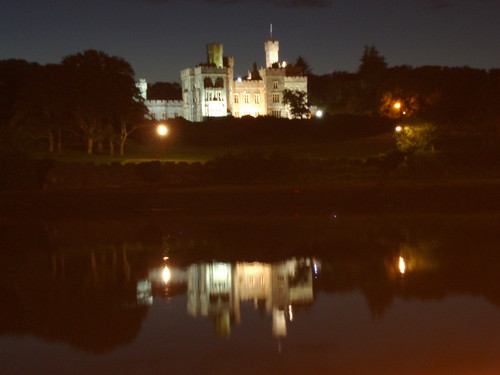
Monday 24 December 2007
Wednesday 12 December 2007
An afternoon at Gress Beach
On Monday afternoon, I went to Gress, with the aim of locating some of the wargraves in the local cemetery. Having achieved that objective, I ambled down to the beach along the river. Although it was barely above freezing, the cloudscapes and light were magnificent.
[caption id="" align="alignnone" width="500" caption="Lichen mottled gravestone, set against the dunes"]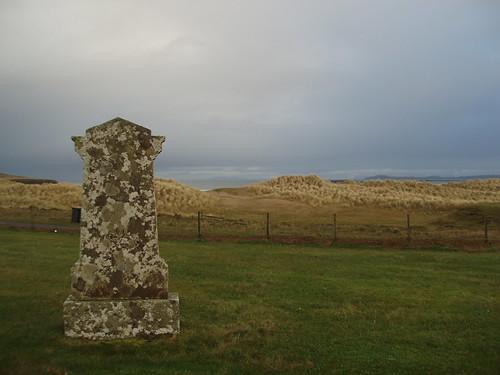 [/caption]
[/caption]
[caption id="" align="alignnone" width="500" caption="Light over the Gress River, overlooked by Lighthill, Back"]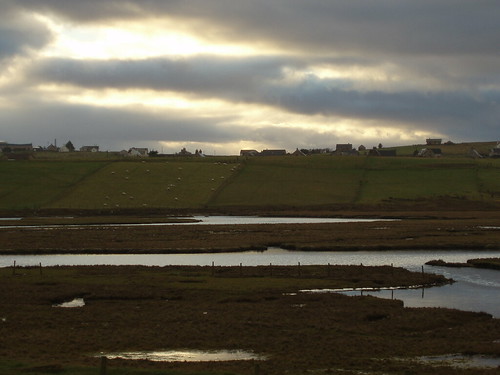 [/caption]
[/caption]
[caption id="" align="alignnone" width="500" caption="Gress River from the old road bridge"] [/caption]
[/caption]
[caption id="" align="alignnone" width="500" caption="Lines of surf on Gress Beach"] [/caption]
[/caption]
[caption id="" align="alignnone" width="240" caption="Ice in the verge of the road at Na Creachan"]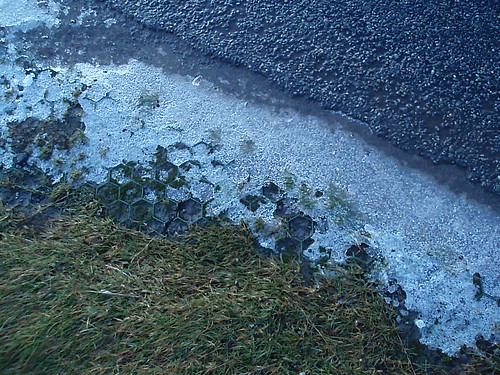 [/caption]
[/caption]
[caption id="" align="alignnone" width="500" caption="Lichen mottled gravestone, set against the dunes"]
 [/caption]
[/caption][caption id="" align="alignnone" width="500" caption="Light over the Gress River, overlooked by Lighthill, Back"]
 [/caption]
[/caption][caption id="" align="alignnone" width="500" caption="Gress River from the old road bridge"]
 [/caption]
[/caption][caption id="" align="alignnone" width="500" caption="Lines of surf on Gress Beach"]
 [/caption]
[/caption][caption id="" align="alignnone" width="240" caption="Ice in the verge of the road at Na Creachan"]
 [/caption]
[/caption]
Friday 7 December 2007
Golf on Sunday
[caption id="" align="alignnone" width="500" caption="Stornoway Golf Course under snow, March 2006"]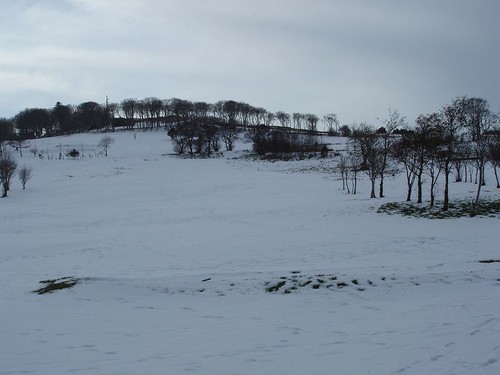 [/caption]
[/caption]
Stornoway Golf Club have applied to their landlord, the Stornoway Trust, for permission to play golf on Sunday. A previous application, 2 years ago, was turned down with a unanimous vote. Having sought legal advice, the Golf Club have announced that another refusal to play golf on Sunday will result in a legal challenge.
Quite frankly, I do not see what harm a game of golf does on Sunday, bearing in mind that the golf course lies outside the town centre.
 [/caption]
[/caption]Stornoway Golf Club have applied to their landlord, the Stornoway Trust, for permission to play golf on Sunday. A previous application, 2 years ago, was turned down with a unanimous vote. Having sought legal advice, the Golf Club have announced that another refusal to play golf on Sunday will result in a legal challenge.
Quite frankly, I do not see what harm a game of golf does on Sunday, bearing in mind that the golf course lies outside the town centre.
Thursday 6 December 2007
Economy and environment
These two factors in island life are presently on a collision course.
The North Lewis Windfarm, which would see 181 turbines scattered over the 40 miles between Stornoway, Bragar and Port of Ness, has been billed as the salvation to the economy of the Western Isles. The developers of this windfarm, Lewis Wind Power, claim that it could bring 400 jobs to the islands. The project is worth £512 million.
On Tuesday of this week, a deal was struck between LWP and the current operators of the Arnish Fabrication Yard, who are working under the name Camcal. Under the terms of this agreement, the Yard would manufacture the turbine towers as a whole. This would generate work for 50 to 70 workers over a period of 5 years.
This is of course depending on whether the Scottish Government approves the scheme. One of the major objectors, the RSPB, has threatened to take the UK Government to court if the Scottish Government does give the green light to the windfarm. The RSPB alleges that the environmental impact study, a requirement for the windfarm planning application, was not carried out properly. If the European Court finds in favour of the RSPB, the UK government is liable for a multi-million pound fine.
It is probably more likely that a public inquiry will be held into the whole scheme.
A parallel can be drawn between a certain golf course development some 200 miles east of Lewis, sponsored by a certain billionnaire whose roots lie a few miles north of Stornoway. When this development was voted down by the local council a week ago, all hell broke loose in the local community, who found themselves deprived of a £1 billion business opportunity. The Scottish Government got involved, and the whole process is going to take rather longer than originally anticipated.
The parallel is about the influence of big money.
I have made my personal opposition to the windfarm clear in many previous posts. One of the reasons is the economic and monetary benefits for the Western Isles. Fifty to seventy jobs stand to be generated at Arnish for 5 years, which (objectively speaking) is a good thing. Other jobs will be generated through the construction of the towers on site. To my layman's eye, the promise of 400 jobs will never be met.
The compensation to the local community, £5 million per annum, is derisory, when compared to the amount of money that will be made by the developers. LWP stands to make huge gains, and represent a company with multi-billion pound assets. These factors have given them the leverage to sway councillors' opinions; it meant that they got away with an incomplete planning application - if the RSPB are anywhere near right. The environment comes a paltry last on the balance-sheet for big money.
The local council sold us down the river. I hope the buck stops at Holyrood.
The North Lewis Windfarm, which would see 181 turbines scattered over the 40 miles between Stornoway, Bragar and Port of Ness, has been billed as the salvation to the economy of the Western Isles. The developers of this windfarm, Lewis Wind Power, claim that it could bring 400 jobs to the islands. The project is worth £512 million.
On Tuesday of this week, a deal was struck between LWP and the current operators of the Arnish Fabrication Yard, who are working under the name Camcal. Under the terms of this agreement, the Yard would manufacture the turbine towers as a whole. This would generate work for 50 to 70 workers over a period of 5 years.
This is of course depending on whether the Scottish Government approves the scheme. One of the major objectors, the RSPB, has threatened to take the UK Government to court if the Scottish Government does give the green light to the windfarm. The RSPB alleges that the environmental impact study, a requirement for the windfarm planning application, was not carried out properly. If the European Court finds in favour of the RSPB, the UK government is liable for a multi-million pound fine.
It is probably more likely that a public inquiry will be held into the whole scheme.
A parallel can be drawn between a certain golf course development some 200 miles east of Lewis, sponsored by a certain billionnaire whose roots lie a few miles north of Stornoway. When this development was voted down by the local council a week ago, all hell broke loose in the local community, who found themselves deprived of a £1 billion business opportunity. The Scottish Government got involved, and the whole process is going to take rather longer than originally anticipated.
The parallel is about the influence of big money.
I have made my personal opposition to the windfarm clear in many previous posts. One of the reasons is the economic and monetary benefits for the Western Isles. Fifty to seventy jobs stand to be generated at Arnish for 5 years, which (objectively speaking) is a good thing. Other jobs will be generated through the construction of the towers on site. To my layman's eye, the promise of 400 jobs will never be met.
The compensation to the local community, £5 million per annum, is derisory, when compared to the amount of money that will be made by the developers. LWP stands to make huge gains, and represent a company with multi-billion pound assets. These factors have given them the leverage to sway councillors' opinions; it meant that they got away with an incomplete planning application - if the RSPB are anywhere near right. The environment comes a paltry last on the balance-sheet for big money.
The local council sold us down the river. I hope the buck stops at Holyrood.
Tuesday 4 December 2007
The money pit
The Western Isles Health Board, currently nearly £4 million in the red, will not be handed a pot of money by the Scottish Government. Instead, the Health Secretary has announced that the Board will be assisted in moving forward in a constructive fashion. Health Board staff have demanded an inquiry, alleging weak management and lack of budgetary control. The Minister has not ruled out that such an inquiry could yet be held.
It is a bit disappointing that 15 months after a new management team was installed, nothing has changed on the financial front. Methinks it does need looking into, even though it was stated during the annual review yesterday that NHS Western Isles would remain autonomous.
It is a bit disappointing that 15 months after a new management team was installed, nothing has changed on the financial front. Methinks it does need looking into, even though it was stated during the annual review yesterday that NHS Western Isles would remain autonomous.
Monday 26 November 2007
Sunday sailings
I found it quite interesting to hear that the possibility of Sunday sailings will be discussed at a Calmac Board meeting on Wednesday. What makes it even more interesting is the demographics of the opposing camps.
Thousands are rumoured to have signed a petition, spearheaded by the Lord's Day Observance Society, opposing Sunday sailings. A couple of dozen have contacted Calmac to ask the ferry operators for a Sunday sailing.
I am aware of the sensitivities involved, and that those commenting on balance appear to be opposed. However, I do have to point out that legally speaking, the opponents haven't got a leg to stand on. How come?
1) Ferries already ply to and from and within the Southern Isles on Sunday, so why not from Lewis?
2) Planes already fly in an out of Stornoway Airport on Sunday, so why shouldn't ferries sail out of Stornoway harbour?
Am awaiting outcome of said Board meeting with bated breath.
EDIT
Calmac have postponed this discussion for 2 months, in order that it does not interfere with a debate about Road-Equivalent Tarriff. This would mean that ferry travel would cost the same as travelling the same distance by road. The Stornoway to Ullapool ferry is one of the routes under consideration for this.
Thousands are rumoured to have signed a petition, spearheaded by the Lord's Day Observance Society, opposing Sunday sailings. A couple of dozen have contacted Calmac to ask the ferry operators for a Sunday sailing.
I am aware of the sensitivities involved, and that those commenting on balance appear to be opposed. However, I do have to point out that legally speaking, the opponents haven't got a leg to stand on. How come?
1) Ferries already ply to and from and within the Southern Isles on Sunday, so why not from Lewis?
2) Planes already fly in an out of Stornoway Airport on Sunday, so why shouldn't ferries sail out of Stornoway harbour?
Am awaiting outcome of said Board meeting with bated breath.
EDIT
Calmac have postponed this discussion for 2 months, in order that it does not interfere with a debate about Road-Equivalent Tarriff. This would mean that ferry travel would cost the same as travelling the same distance by road. The Stornoway to Ullapool ferry is one of the routes under consideration for this.
Health Board saga rumbles on
Two years after a public meeting in Stornoway Town Hall, decrying the management of NHS Western Isles, another public move is afoot. As the Health Minister is due to conduct the Annual Review of the organisation on December 3rd, a petition is being circulated in the islands against the current management. Staff still appear to have no confidence in the management, in spite of the fact that the top tier was replaced a year ago.
NHS Western Isles continues to be in the red to the tune of £3 million, which is cause for grave concern. It is worth noting that although the Chairman, Chief Executive and Medical Director were all replaced in 2006, the Finance Director was not.
NHS Western Isles continues to be in the red to the tune of £3 million, which is cause for grave concern. It is worth noting that although the Chairman, Chief Executive and Medical Director were all replaced in 2006, the Finance Director was not.
Friday 23 November 2007
Last visit

This is MV Explorer, reported to be going down off the South Shetland Islands near Antarctica. She hit a chunk of ice, which ripped a hole in her hull, several inches wide. The ship is listing at 25 degrees and expected to sink.
Its 100 passengers and all but two of its 54 crew are in liferafts. Another ship is on its way to pick them up.
The connection to Lewis? Explorer visited Stornoway at least twice in the past two years, latterly on May 12 this year, when above picture was taken. On her last visit.
Wednesday 14 November 2007
Fire at Stornoway sorting office

Yesterday morning at 10 am, the fire brigade were called to the Royal Mail sorting office at Sandwick Road in Stornoway. A fire had broken out in the roofspace on the building. Fifteen members of staff were evacuated, but no injuries were reported.
Deliveries of mail were disrupted, as Royal Mail pledged to salvage as much of the remaining mail as possible. Today, no mail will be brought to the island - whether any mail will be taken out has not become clear at time of writing.
Fire engines were recalled to the building at 7pm last night, as the fire had reignited. The building was severely damaged; the above picture shows the two broken windows and two broken skylights which is external evidence of the blaze. It is thought to have been caused by an electrical fault in the roofspace.
Royal Mail is now urgently seeking alternative premises to resume services.
Open and shut (repeat at leisure)
The Arnish Fabrication Yard is yet again to be mothballed. As an acquaintance put it this morning, it's now got more mothballs than a wardrobe. It's getting tedious. This is the third time that the Yard has been put on a care-and-maintenance basis, but listen up, folks: this time it's not a company failure. Hurray.
According a spokesman from the Yard, there is a dearth of orders for renewable energy components (such as turbine towers). Even if an order came through today, it would take three months before the Yard could swing into action. The heavy demand for base materials for renewables means that delivery times are long. Right. So, there is such a demand for renewable energy components, yet no orders. Correct. The planning process is putting a spanner in the wheels. Two projects are being considered at present, which the Yard has bid for.
I think everybody is now fully convinced that if you want secure and long term employment in the engineering sector in Lewis, the Arnish Fabrication Yard does not appear to occupy top spot in the listings for reliability. As I indicated in my first paragraph, this opening-and-closing pendulum is once again in full swing. Previously, the closures were due to company failures, with tens of millions of public money going down the drain.
The irony of this whole situation is that the Fabrication Yard, and the work for the Lewis Windfarms (if and when they are given final approval) was supposed to be the salvation of the island economy. It was one of the reasons for Comhairle nan Eilean Siar to approve the North Lewis and Eisgein windfarm projects.
Talking of windfarm projects, it appears that the Eishken estate owner is trying to undo his earlier reduction in windturbine numbers for the Eisgein project by submitting piecemeal applications, each below the 50MW threshold above which Scottish Ministers would have had to give approval. Now the local authority can do it all by themselves. And judging by previous experience, the rubber stamp will take centre-stage in proceedings. I have made my dismay at this tactic clear in an earlier post.
According a spokesman from the Yard, there is a dearth of orders for renewable energy components (such as turbine towers). Even if an order came through today, it would take three months before the Yard could swing into action. The heavy demand for base materials for renewables means that delivery times are long. Right. So, there is such a demand for renewable energy components, yet no orders. Correct. The planning process is putting a spanner in the wheels. Two projects are being considered at present, which the Yard has bid for.
I think everybody is now fully convinced that if you want secure and long term employment in the engineering sector in Lewis, the Arnish Fabrication Yard does not appear to occupy top spot in the listings for reliability. As I indicated in my first paragraph, this opening-and-closing pendulum is once again in full swing. Previously, the closures were due to company failures, with tens of millions of public money going down the drain.
The irony of this whole situation is that the Fabrication Yard, and the work for the Lewis Windfarms (if and when they are given final approval) was supposed to be the salvation of the island economy. It was one of the reasons for Comhairle nan Eilean Siar to approve the North Lewis and Eisgein windfarm projects.
Talking of windfarm projects, it appears that the Eishken estate owner is trying to undo his earlier reduction in windturbine numbers for the Eisgein project by submitting piecemeal applications, each below the 50MW threshold above which Scottish Ministers would have had to give approval. Now the local authority can do it all by themselves. And judging by previous experience, the rubber stamp will take centre-stage in proceedings. I have made my dismay at this tactic clear in an earlier post.
Saturday 10 November 2007
Turbine woes

Above image courtesy Minnesota's Energy Future.
Read in the regional press today (Saturday) that a number of windfarms were taken off-line for the generation of electricity on Thursday. Reason being that a turbine tower had actually collapsed during 50 mph winds on the Mull of Kintyre. Similar incidents were quoted from elsewhere in the UK and the world at large in recent years. An investigation into the Kintyre collapse is in progress; nobody was hurt.
Such a catastrophic structural failure can have various causes, varying from design flaws to faults due to a manufacturing defect. If this is a recurring phenomenon, then wind turbines appear not to be the tried and tested technology that they are made out to be.
Winds of 50 mph, equating to force 10 on the Beaufort scale, are unusual but certainly not unheard of in the Western Isles. Gusts of that magnitude and greater occurred at regular intervals during last Thursday's gales.
Wednesday 7 November 2007
Health Board Finances
NHS Western Isles is once again under the spotlight over its financial management, or lack of it as the case may be. Last year, as this blog also reported, the top slice of management was replaced following allegations of bullying and harassment, as well as failures in management generally.
A new management team was installed by the then Scottish Executive. They were set a financial target of break-even by September 2007, which has not been met. The local NHS still has a deficit in excess of £3 million. A report by the Auditor General of Scotland has identified lack of financial management and serious issues in the running of the board generally.
Although I echo the statement by our MSP that it is time all the facts about the local NHS came above board, I think it is also time a firm plan of action is put forward by the management at the Health Board, with a clear and realistic strategy on how this be achieved.
The primary objective is of course to reduce the deficit to zero without affecting patient care. The secondary objective is to do so with full support from staff (which is where the previous administration went wrong).
A new management team was installed by the then Scottish Executive. They were set a financial target of break-even by September 2007, which has not been met. The local NHS still has a deficit in excess of £3 million. A report by the Auditor General of Scotland has identified lack of financial management and serious issues in the running of the board generally.
Although I echo the statement by our MSP that it is time all the facts about the local NHS came above board, I think it is also time a firm plan of action is put forward by the management at the Health Board, with a clear and realistic strategy on how this be achieved.
The primary objective is of course to reduce the deficit to zero without affecting patient care. The secondary objective is to do so with full support from staff (which is where the previous administration went wrong).
Thursday 1 November 2007
Armistice 1918 - 2007
On Sunday 11 November, commemorations will take place across the country for the 89th anniversary of the end of World War I. Bearing in mind the percentagewise large proportion of men from Lewis who laid down their lives for King and Country, I am compiling a tribute page, derived from the Faces of the War Memorial site.
I have selected at random one individual from each of the 100 villages in Lewis and have added a portrait photograph (if available) and a summary of his personal information. A modern photograph of the village in question is provided as well, where available.
The page is still being added to.
The result looks like this:
CARLOWAY
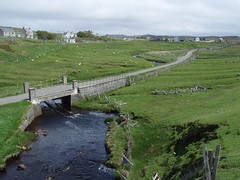
Private DONALD MACIVER

Last address in Lewis: 2 Carloway,
Regiment or division: Cameron Highlanders
Date of death: 9 May 1915 at the age of 19
Killed in action in La Bassee
Had been at front since October 1914
I have selected at random one individual from each of the 100 villages in Lewis and have added a portrait photograph (if available) and a summary of his personal information. A modern photograph of the village in question is provided as well, where available.
The page is still being added to.
The result looks like this:
CARLOWAY

Private DONALD MACIVER

Last address in Lewis: 2 Carloway,
Regiment or division: Cameron Highlanders
Date of death: 9 May 1915 at the age of 19
Killed in action in La Bassee
Had been at front since October 1914
Wednesday 31 October 2007
Maritime Building no more
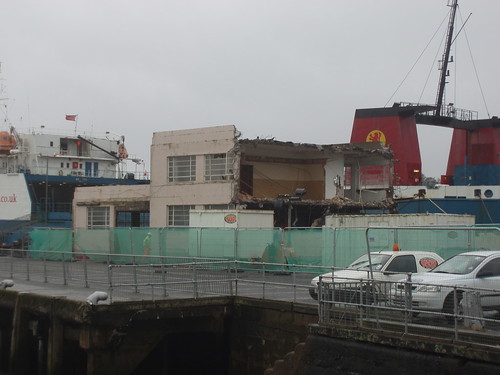
The Maritime Building on Pier no 1 in Stornoway is being demolished at the moment. Following a council proposal to take the listed building down, no objections were filed, so the demolition is going ahead.
I would imagine that expats around the country and around the world will be a bit sad at the disappearance of this Stornoway landmark.
The Maritime Building used to house the Caledonian MacBrayne offices, ticket office for the ferry and latterly an insurance business. It was erected in the 1930s, and saw islanders leave for World War II as well as pastures new in many cases. It was the scene for many a fond welcome home, and for many a tearful farewell. In many cases, the farewell was for good.
After the ferry terminal located to its present position, at no 3 pier, the terminal on pier no 1 fell into disuse. At the moment, the freight ferry, Muirneag, docks there through the day.
The picture at the top of this post shows the current state of affairs. The picture below was taken earlier in the year.
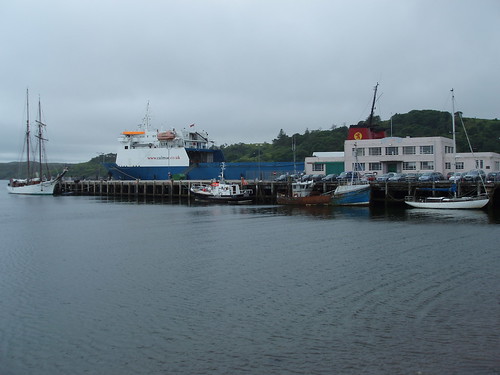
Lewis Windfarms
I've made my opposition to the proposed windfarms in Lewis clear on more than one occasion. In a recent entry, I have stated my case for that.
First Minister Alex Salmond appears to think that the Highlands and Islands should become the powerhouse of Europe, with a cable-link to Scandinavia rather than the rest of the UK. The Highlands and Islands will be the crown of Scotland in that respect, with energy generated from marine-based technology and other sources.
I just hope this crown doesn't become a crown of thorns, with windfarms at every corner, just for the sake of convenience and to line the pockets of the developers.

First Minister Alex Salmond appears to think that the Highlands and Islands should become the powerhouse of Europe, with a cable-link to Scandinavia rather than the rest of the UK. The Highlands and Islands will be the crown of Scotland in that respect, with energy generated from marine-based technology and other sources.
I just hope this crown doesn't become a crown of thorns, with windfarms at every corner, just for the sake of convenience and to line the pockets of the developers.

Tuesday 30 October 2007
Heartstopping
Found a very disconcerting piece of news this evening about the new search-and-rescue helicopter.
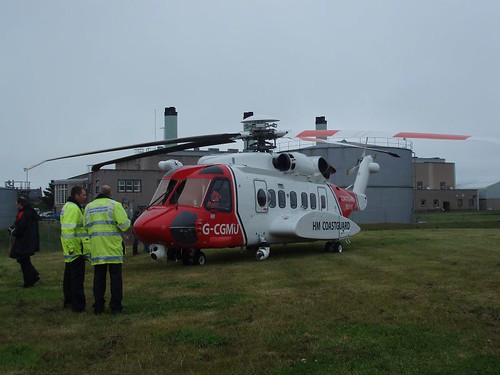
The new aircraft, pictured above on its first introduction to Stornoway on 17 September, carries a defibrillator. This piece of kit is used to administer an electric shock to the hearts of patients whose heart has stopped.
The Civil Aviation Authority has not granted approval for the defibrillators to be used, as their electronic safety is not guaranteed. By that is meant that the electronic impulses from the machine may interfere with the electronics on board the aircraft.
Concerns have also been expressed over the lack of a track record in SAR with this new machine.
The uselessness of the defibrillators is something of grave concern. Wonder how they're going to sort that one out.

The new aircraft, pictured above on its first introduction to Stornoway on 17 September, carries a defibrillator. This piece of kit is used to administer an electric shock to the hearts of patients whose heart has stopped.
The Civil Aviation Authority has not granted approval for the defibrillators to be used, as their electronic safety is not guaranteed. By that is meant that the electronic impulses from the machine may interfere with the electronics on board the aircraft.
Concerns have also been expressed over the lack of a track record in SAR with this new machine.
The uselessness of the defibrillators is something of grave concern. Wonder how they're going to sort that one out.
Wednesday 24 October 2007
Stornoway notes
In recent weeks, I was pleased to notice a few changes around town. The area around the Nicolson clocktower has been turned into a public amenity, focused on skate boarders. A few seating benches are provided as well, for those less inclined to chance life and limb on the jumps.
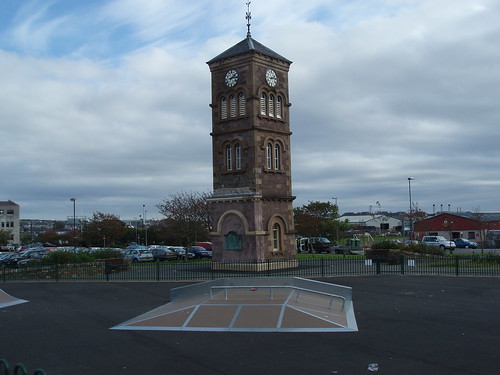
Museum nan Eilean, on Francis Street, reopened at the end of September with a new exhibition, entitled Fonn is Duthchas. This now stretches across both floors of the museum building. It is a focus on all aspects of the Highlands and Islands. A good preview can be had on this website. The exhibition, which has toured several major venues in Scotland, closes on 1 December.
The accommodation block for Lews Castle College, on Bayhead, appears to be in use, although it is by no means complete. I have no information on progress, so comments on that welcome. The building has taken the place of the old YM building, which was demolished a year ago. Although largely hidden from view by trees, it does look quite smart and appears to fit in well with surroundings.
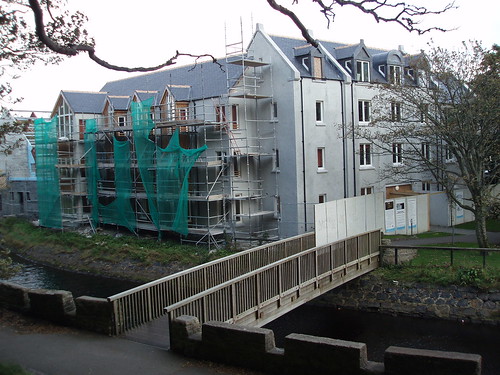
The view along Newton Street has been substantially altered, following the demolition of the four fuel tanks in front of the powerstation at the Battery over the past couple of weeks. This should also be obvious from the ferry.
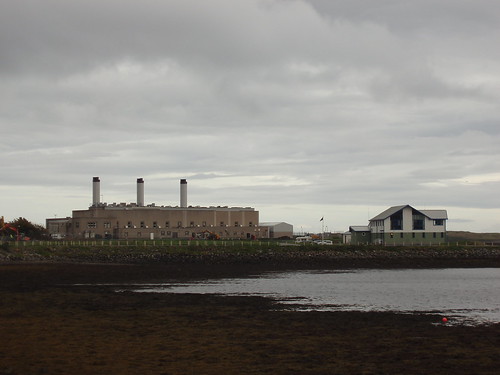
Finally, Stornoway's collection of fine cast-iron railings will be photographed in the weeks to come. Unlike most towns in the UK, Stornoway's railings were not ripped out during World War II to assist in the war effort. A largely futile effort, as you cannot melt down cast iron.
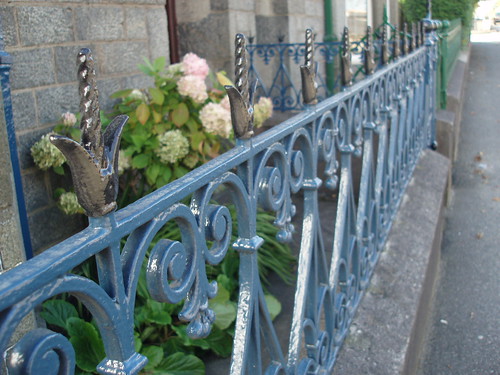

Museum nan Eilean, on Francis Street, reopened at the end of September with a new exhibition, entitled Fonn is Duthchas. This now stretches across both floors of the museum building. It is a focus on all aspects of the Highlands and Islands. A good preview can be had on this website. The exhibition, which has toured several major venues in Scotland, closes on 1 December.
The accommodation block for Lews Castle College, on Bayhead, appears to be in use, although it is by no means complete. I have no information on progress, so comments on that welcome. The building has taken the place of the old YM building, which was demolished a year ago. Although largely hidden from view by trees, it does look quite smart and appears to fit in well with surroundings.

The view along Newton Street has been substantially altered, following the demolition of the four fuel tanks in front of the powerstation at the Battery over the past couple of weeks. This should also be obvious from the ferry.

Finally, Stornoway's collection of fine cast-iron railings will be photographed in the weeks to come. Unlike most towns in the UK, Stornoway's railings were not ripped out during World War II to assist in the war effort. A largely futile effort, as you cannot melt down cast iron.

Monday 22 October 2007
Orchestrion
On my travels I visited the Isle of Rum and the Castle at Kinloch. Among other oddities, it contains a fully functional orchestrion. Basically, a mechanised orchestra. The sound is phenomenal and can be heard across the castle. To think it all fits under the stairs...
httpv://www.youtube.com/watch?v=6kiCxd4TMVw
httpv://www.youtube.com/watch?v=6kiCxd4TMVw
Thursday 18 October 2007
Returned to post
After a couple of days on the mainland, yours truly is back on post to post, if you'll forgive the twisted grammar. Had the pleasure to travel to Glasgow the scenic route, of which I'll publish a selection of pictures later.
Here in Lewis, the summer has long gone, and now the winter timetable for public transport is set to come into force on Monday, 22 October. The Stornoway to Ullapool ferry does not alter its schedule, but other ferries do. Please check the Calmac timetables before you set off. And don't forget they're printed using the 24 hour clock. I won't easily forget the poor folk from a place that will remain unnamed who were enjoying their picknick on a hillside overlooking a certain ferryport at 2pm (1400 hours) one day. They enjoyed the beautiful vista of the ferry leaving port. Next one due at 4pm. Really? Nope, not until the next morning.
The bus timetable will be slightly reduced, but on the whole not a marked deterioration. I've said in the past that the Lewis buses provide a good service, except if you want to go to Uig (West Lewis).
I hope that outdated timetables are removed from shelters around the area, unlike Uig in Skye where the winter timetables from the previous winter were still posted on the ferry terminal last week. Come on, Skye, you can do a heck of a lot better than that.
Whilst travelling from Uig to Portree, the bus was briefly halted at the Skeabost junction to allow three trailers with massive turbine sections to pass in the opposite direction. These are due to be installed at the Ben Aketil windfarm near Dunvegan.
I also visited the Isle of Rum and Kinloch Castle, which should be renovated with support from the Phoenix Trust (a charity patronised by Prince Charles) at the cost of 10 to 15 million pounds, a three-fold increase as compared to the cost quoted in 2004. I hope this work will actually be carried out. Kinloch Castle is a unique but fading look back in time, set in the most incongruous of settings.
Here in Lewis, the summer has long gone, and now the winter timetable for public transport is set to come into force on Monday, 22 October. The Stornoway to Ullapool ferry does not alter its schedule, but other ferries do. Please check the Calmac timetables before you set off. And don't forget they're printed using the 24 hour clock. I won't easily forget the poor folk from a place that will remain unnamed who were enjoying their picknick on a hillside overlooking a certain ferryport at 2pm (1400 hours) one day. They enjoyed the beautiful vista of the ferry leaving port. Next one due at 4pm. Really? Nope, not until the next morning.
The bus timetable will be slightly reduced, but on the whole not a marked deterioration. I've said in the past that the Lewis buses provide a good service, except if you want to go to Uig (West Lewis).
I hope that outdated timetables are removed from shelters around the area, unlike Uig in Skye where the winter timetables from the previous winter were still posted on the ferry terminal last week. Come on, Skye, you can do a heck of a lot better than that.
Whilst travelling from Uig to Portree, the bus was briefly halted at the Skeabost junction to allow three trailers with massive turbine sections to pass in the opposite direction. These are due to be installed at the Ben Aketil windfarm near Dunvegan.
I also visited the Isle of Rum and Kinloch Castle, which should be renovated with support from the Phoenix Trust (a charity patronised by Prince Charles) at the cost of 10 to 15 million pounds, a three-fold increase as compared to the cost quoted in 2004. I hope this work will actually be carried out. Kinloch Castle is a unique but fading look back in time, set in the most incongruous of settings.
Wednesday 10 October 2007
Southwest 5
That about sums up our average wind forecast. It doesn't mention the once a week gales (don't you just love the way you can make statistics look so bonny). It is one of the reasons why the Western Isles was earmarked as a prime site for a windfarm. Or three.
Following my previous post, I think I'd better summarise the reasons for my opposition to the turbines, of which 300 are planned to be dotted across the island of Lewis.
1. Oil and gas are finite sources of energy, and alternatives will have to be found within a matter of years or decades. Nuclear energy is something I'm opposed to, so long as a safe method of disposing of the waste is not found. Sandside Beach at Dounreay, nor Fuday nor Sandray count as safe.
2. The wind blows free for all, and I'm not opposed to windpower persé. However, the question of energy provision should be answered using all sources of renewable or non-carbon based energy.
3. A wavepower plant was commissioned off Eday, Orkney Isles, the other day. A tidal power generator has been providing Islay with electricity for about 15 years now. Another tidal generator is being built at Shader, Barvas (Lewis). Wave and tidal generators on a small scale are unobtrusive. The barrage that was mooted for the Severn estuary has an enormous environmental impact. Street- lights at Cromor and Ranais in Lewis are powered by solar energy. The panels aren't much to look at, but they're only small.
4. Large windpower developments across the UK come in for strong local opposition, because of the impact on the view - and yes, you can make a living off the view, it's called tourism - and the quality of life. Windturbines are NOT silent. Their presence can also put off prospective homebuyers, making properties unsellable.
5. The three Lewis windfarms, in Eisgein, Pairc and North Lewis, will have a major environmental impact. Wildlife, disturbance of the peatlayer (up to 20 feet thick in places), and destruction of one of the last wildernesses in the UK, which people come specifically to visit. The compensation offered to local communities is derisory. When hundreds of millions if not billions of pounds are being made, I think £5 million a year for the North Lewis windfarm is an insult, like offering the natives beads and mirrors.
6. The promises of employment, arising from the construction of the windfarm and associated infrastructure, are overstated. The Arnish Fabrication Yard has shown to be fickle in its economic stability, and that's where all the turbines are to be manufactured? 400 jobs for the construction phase, and 25 for the maintenance phase. I strongly doubt whether Lewisians in exile will come flocking back to take that up.
In brief, the question of our energy provision needs to be addressed in a wider perspective. It's never a good idea to put all your eggs in the one basket, marked windpower in this case.
Following my previous post, I think I'd better summarise the reasons for my opposition to the turbines, of which 300 are planned to be dotted across the island of Lewis.
1. Oil and gas are finite sources of energy, and alternatives will have to be found within a matter of years or decades. Nuclear energy is something I'm opposed to, so long as a safe method of disposing of the waste is not found. Sandside Beach at Dounreay, nor Fuday nor Sandray count as safe.
2. The wind blows free for all, and I'm not opposed to windpower persé. However, the question of energy provision should be answered using all sources of renewable or non-carbon based energy.
3. A wavepower plant was commissioned off Eday, Orkney Isles, the other day. A tidal power generator has been providing Islay with electricity for about 15 years now. Another tidal generator is being built at Shader, Barvas (Lewis). Wave and tidal generators on a small scale are unobtrusive. The barrage that was mooted for the Severn estuary has an enormous environmental impact. Street- lights at Cromor and Ranais in Lewis are powered by solar energy. The panels aren't much to look at, but they're only small.
4. Large windpower developments across the UK come in for strong local opposition, because of the impact on the view - and yes, you can make a living off the view, it's called tourism - and the quality of life. Windturbines are NOT silent. Their presence can also put off prospective homebuyers, making properties unsellable.
5. The three Lewis windfarms, in Eisgein, Pairc and North Lewis, will have a major environmental impact. Wildlife, disturbance of the peatlayer (up to 20 feet thick in places), and destruction of one of the last wildernesses in the UK, which people come specifically to visit. The compensation offered to local communities is derisory. When hundreds of millions if not billions of pounds are being made, I think £5 million a year for the North Lewis windfarm is an insult, like offering the natives beads and mirrors.
6. The promises of employment, arising from the construction of the windfarm and associated infrastructure, are overstated. The Arnish Fabrication Yard has shown to be fickle in its economic stability, and that's where all the turbines are to be manufactured? 400 jobs for the construction phase, and 25 for the maintenance phase. I strongly doubt whether Lewisians in exile will come flocking back to take that up.
In brief, the question of our energy provision needs to be addressed in a wider perspective. It's never a good idea to put all your eggs in the one basket, marked windpower in this case.
Thursday 4 October 2007
Eishken
The southern aspect of the Arnish Lighthouse is a red sector, and today that was true in more than one sense.
The owner of the Eishken estate announced he was going to submit a planning application for 16 turbines to be constructed on his estate. According to planning rules, windfarms with an output below 50 MW do not require Scottish Government approval. The local authority can give final go-ahead.
Isn't that clever, said he through gritted teeth. This comes ON TOP of the 53 turbine Muaitheabhal Windfarm, so magnanimously reduced from an original 133. Bearing in mind the rubberstamp attitude that the Comhairle has to large windfarm projects (and don't be fooled, this one is more than likely to be 16 turbines each standing 500 feet tall) we can expect 16 turbines on the Eishken Estate in short order.
In the nearly three years that I have been in Lewis, there was always this plot of land for sale along the Eishken Road, near Seaforth Head - 4 miles southeast of Balallan. I have always found it to have a special lure. Remote, nearest neighbour half a mile away, no facilities, back to basics. The antidote was the prospect of an Eishken Windfarm - which will stand directly across the water. Worse than spoiling the view of a solitary house, it will impact the visual aspect of the Harris Hills.
The owner of the Eishken estate announced he was going to submit a planning application for 16 turbines to be constructed on his estate. According to planning rules, windfarms with an output below 50 MW do not require Scottish Government approval. The local authority can give final go-ahead.
Isn't that clever, said he through gritted teeth. This comes ON TOP of the 53 turbine Muaitheabhal Windfarm, so magnanimously reduced from an original 133. Bearing in mind the rubberstamp attitude that the Comhairle has to large windfarm projects (and don't be fooled, this one is more than likely to be 16 turbines each standing 500 feet tall) we can expect 16 turbines on the Eishken Estate in short order.
In the nearly three years that I have been in Lewis, there was always this plot of land for sale along the Eishken Road, near Seaforth Head - 4 miles southeast of Balallan. I have always found it to have a special lure. Remote, nearest neighbour half a mile away, no facilities, back to basics. The antidote was the prospect of an Eishken Windfarm - which will stand directly across the water. Worse than spoiling the view of a solitary house, it will impact the visual aspect of the Harris Hills.
Thursday 27 September 2007
Arnish Fabrication Yard
So, we're back to square one. The current operators of the Fabrication Yard have announced they'll be winding down operations after the current order is completed in November. They blame delays caused by public inquiries and government for the drop-off in orders for renewables (is that so?), and will need more money to keep the place going.
AGAIN?
This is the third time that the Fabrication Yard has been allowed to go down the tubes, following an injection of substantial amounts of public money. The Yard was hailed as the salvation of the Lewis economy, particularly with the three windfarms that are planned for the island. I rather think that the operators should be more pro-active in acquiring orders from elsewhere, rather than sitting on their backsides and waiting for the orders to walk in the door.
It is a disgrace that this situation is allowed to develop again, and if the Arnish Yard does close again, I'd be sorely tempted to recommend Western Isles Enterprise demand their money back from current operators.
Even if the Yard was at one time the perceived salvation of the Lewis economy, there will be hardly anybody left believing that.
AGAIN?
This is the third time that the Fabrication Yard has been allowed to go down the tubes, following an injection of substantial amounts of public money. The Yard was hailed as the salvation of the Lewis economy, particularly with the three windfarms that are planned for the island. I rather think that the operators should be more pro-active in acquiring orders from elsewhere, rather than sitting on their backsides and waiting for the orders to walk in the door.
It is a disgrace that this situation is allowed to develop again, and if the Arnish Yard does close again, I'd be sorely tempted to recommend Western Isles Enterprise demand their money back from current operators.
Even if the Yard was at one time the perceived salvation of the Lewis economy, there will be hardly anybody left believing that.
The Faroese model
Øli Breckmann is a senior politician from the Faroes (an island group midway between Scotland and Iceland), who has called on the Highlands and Islands to emulate the Faroese model. The Faroes, an archipelago of 18 islands and 49,000 people, are an autonomous region of Denmark. The Faroese speak their own language, which is a close cousin of Icelandic, and according to Mr Breckmann, it has been the language which has proven to be the cornerstone under their success. It is used in all aspects of daily life.
The parallel with the Highlands and Islands is that Gaelic is spoken in the Western Isles (and that description stretches from Islay to Lewis) as well as in large swathes of the Scottish mainland. It should be noted that Orkney and Shetland do NOT have that link, as their heritage is more Scandinavian oriented.
Mr Breckmann has suggested that the H&I use their cultural identity and difference from the rest of the UK to foster economic prosperity and a sense of regional pride.
Methinks this is an interesting observation of the situation that our area finds itself in. This part of Scotland is often compared to outlying areas of Scandinavia, with particularly local politicians looking towards the Lofoden archipelago in northwestern Norway as an example to follow. On the other hand, we have a Nationalist Scottish Government, trying to set Scotland apart from the rest of the UK. I wonder what their stance would be on a Highlands and Islands (the larger part of the Scottish landmass) on a Faroese footing, setting itself apart from the rest of Scotland on the strength of its cultural heritage.
It should be born in mind that Mr Breckmann is a politician on the right of the political spectrum, and his ideas have been publicised by the Policy Institute, which aims to promote a free market economy.
Source: BBC Scotland
The parallel with the Highlands and Islands is that Gaelic is spoken in the Western Isles (and that description stretches from Islay to Lewis) as well as in large swathes of the Scottish mainland. It should be noted that Orkney and Shetland do NOT have that link, as their heritage is more Scandinavian oriented.
Mr Breckmann has suggested that the H&I use their cultural identity and difference from the rest of the UK to foster economic prosperity and a sense of regional pride.
Methinks this is an interesting observation of the situation that our area finds itself in. This part of Scotland is often compared to outlying areas of Scandinavia, with particularly local politicians looking towards the Lofoden archipelago in northwestern Norway as an example to follow. On the other hand, we have a Nationalist Scottish Government, trying to set Scotland apart from the rest of the UK. I wonder what their stance would be on a Highlands and Islands (the larger part of the Scottish landmass) on a Faroese footing, setting itself apart from the rest of Scotland on the strength of its cultural heritage.
It should be born in mind that Mr Breckmann is a politician on the right of the political spectrum, and his ideas have been publicised by the Policy Institute, which aims to promote a free market economy.
Source: BBC Scotland
Monday 24 September 2007
Images of Point

Portnaguran from An t-Siumpan
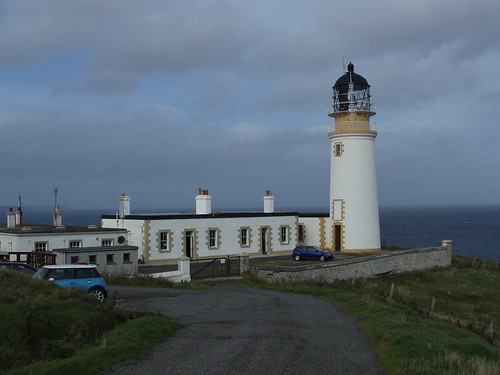
Tiumpan Head Lighthouse
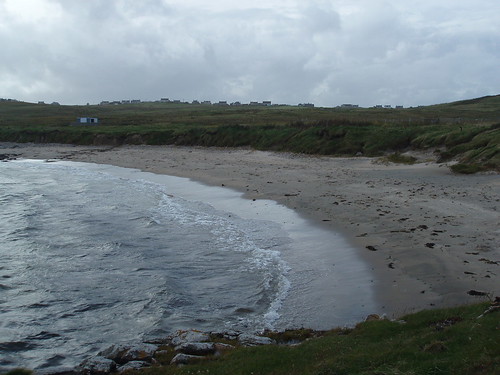
Bayble Beach
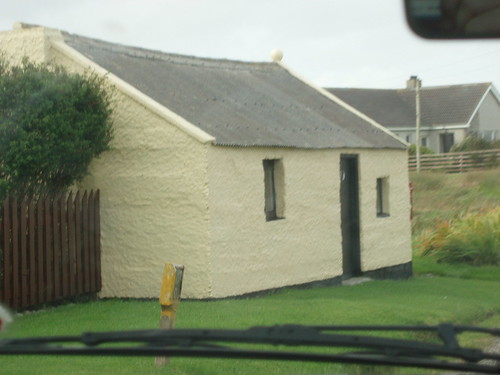
Eagleton
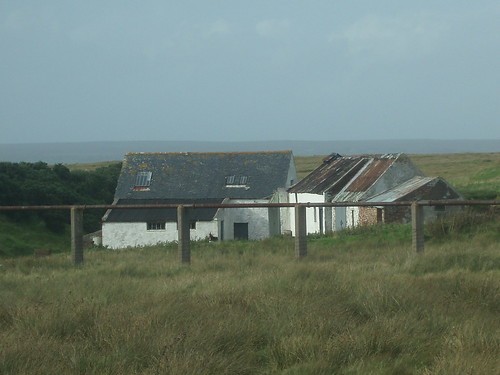
Garrabost Mill
Thursday 20 September 2007
Sunday sailings
It has come to my attention that 37 people have contacted Calmac, requesting them to commence Sunday sailings between Ullapool and Stornoway. This apparently started a week ago, with the majority of this correspondence coming from the Isle of Lewis.
It is possible to reach the mainland on Sunday by travelling from Leverburgh to Berneray, then on to Lochmaddy and by a second ferry to Skye. A circuitous and lengthy detour.
I have given my opinion on Sunday sailings in the past, as I believe it will benefit the island. People working away from the island will be able to come home for the weekend and depart on Sunday, in time to resume their jobs on Monday morning. The same applies to students.
I am aware of objections on religious grounds, and to safeguard a unique way of life, which I would be saddened to see the end of.
Calmac will sign the new service agreement this week, and will consider the Sunday sailings proposals next week.
Source: Hebrides Info
It is possible to reach the mainland on Sunday by travelling from Leverburgh to Berneray, then on to Lochmaddy and by a second ferry to Skye. A circuitous and lengthy detour.
I have given my opinion on Sunday sailings in the past, as I believe it will benefit the island. People working away from the island will be able to come home for the weekend and depart on Sunday, in time to resume their jobs on Monday morning. The same applies to students.
I am aware of objections on religious grounds, and to safeguard a unique way of life, which I would be saddened to see the end of.
Calmac will sign the new service agreement this week, and will consider the Sunday sailings proposals next week.
Source: Hebrides Info
Wednesday 19 September 2007
Education, education, education
Fellow Lewis Islandblogger Peatstack gave a nice summary of the debate, intricacies and opinions regarding the proposed closures of S1 and S2 units at several schools in Lewis. This would see all secondary education, from age 12 onwards, centralised at the Nicolson Institute in Stornoway, with the aforementioned units at Lionel, Shawbost, Back and Sgoil nan Loch closed. Several primary schools would also face permanent closure.
To quote the West Highland Free Press: the Education Minister in the Scottish Government threw a tantrum when she visited Stornoway and had those plans served alongside her cup of tea. The reasoning given by the Comhairle is that the new curriculum, coupled to falling schoolrolls, would make external S1/S2 units economically unviable.
On Tuesday morning, local radiostation Isles FM alerted us to plans to build a new Nicolson Institute on greenfield sites to the east of the urban centre of Stornoway, i.e. at Goathill Farm and Mossend. It's probably a good idea, bearing in mind that the current buildings go back to the 19th century in some cases.
I just scratch my head at the closure of a school like Sgoil nan Loch in 2009, which was built at great expense not much longer than 10 years ago. I thought the S1/S2 units had been implemented to spare young pupils hour long bus journeys to and from school each morning and evening, to allow them to stay in their communities longer. Rather than shelling out on a wholly new Nic, couldn't some of the money be used to maintain the external units?
To quote the West Highland Free Press: the Education Minister in the Scottish Government threw a tantrum when she visited Stornoway and had those plans served alongside her cup of tea. The reasoning given by the Comhairle is that the new curriculum, coupled to falling schoolrolls, would make external S1/S2 units economically unviable.
On Tuesday morning, local radiostation Isles FM alerted us to plans to build a new Nicolson Institute on greenfield sites to the east of the urban centre of Stornoway, i.e. at Goathill Farm and Mossend. It's probably a good idea, bearing in mind that the current buildings go back to the 19th century in some cases.
I just scratch my head at the closure of a school like Sgoil nan Loch in 2009, which was built at great expense not much longer than 10 years ago. I thought the S1/S2 units had been implemented to spare young pupils hour long bus journeys to and from school each morning and evening, to allow them to stay in their communities longer. Rather than shelling out on a wholly new Nic, couldn't some of the money be used to maintain the external units?
Friday 7 September 2007
NHS Western Isles
During 2006, a crisis in the management and finances of the Western Isles Health Board precipitated a wholesale change at the top of the organisation. Chairman, Chief Executive and Medical Director were all replaced.
This afternoon, it was reported that another senior official within the Health Board has been suspended on full pay, prompting a delay in the annual review which was due on Monday 10 September. The Cabinet Secretary for Health was due to visit Stornoway to chair the Annual Review of the Board's performance. In financial terms, this has not improved - there is still a cumulative deficit of around £ 3 million.
The Health Board's website does not give further details, and the Health Minister has expressed disappointment at this turn in events.
Saturday's papers revealed that the Chief Executive had been suspended pending an inquiry into the qualifications he brought into the job.
On Monday, an interim CEO was appointed whilst investigations continue into the suspended CEO's CV.
This afternoon, it was reported that another senior official within the Health Board has been suspended on full pay, prompting a delay in the annual review which was due on Monday 10 September. The Cabinet Secretary for Health was due to visit Stornoway to chair the Annual Review of the Board's performance. In financial terms, this has not improved - there is still a cumulative deficit of around £ 3 million.
The Health Board's website does not give further details, and the Health Minister has expressed disappointment at this turn in events.
Saturday's papers revealed that the Chief Executive had been suspended pending an inquiry into the qualifications he brought into the job.
On Monday, an interim CEO was appointed whilst investigations continue into the suspended CEO's CV.
Thursday 30 August 2007
Faclan - Book Festival
The second Hebridean Book Festival Faclan is being held in Stornoway's arts centre An Lanntair this week. Unlike last year, I am not attending any of the lectures, as I am unfamiliar with the names. I did have a look round the books on sale in the foyer of the centre, but only came away with a transcription of a lecture, given by genealogist Bill Lawson 10 months ago in Gravir, South Lochs. He asserted that Lewis was not as badly affected by the Clearances as other parts of northern Scotland. I was glad to be able to read his well reasoned account, but that doesn't mean I agree with him.
It is immaterial whether a clearance leads to resettlement elsewhere in the island, elsewhere in Scotland or over in Nova Scotia, Canada. It remains a major upheaval. Whether the clearance was voluntary, engineered (through the tried and tested method of bumping up the rent deliberately to beyond the tenants' means), facilitated (passage paid for) - it cannot and should not be negated and belittled the way Mr Lawson does.
I am not a native of these parts, and perhaps can only sense from afar the distress and pain felt by those who were kicked out. I am currently reading a book I bought at last year's Faclan called The Crofters' Trail, which is about clearances all over Scotland.
The link to the present jumped out at me as I was reading a chapter about a clearance in North Uist. In 1987, the author, David Craig, visited the island just as many small island schools were being closed down. One islander complained to him: "It's just like the evictions, this closing of the schools over the children's heads".
There was talk earlier in the week of another round of school closures. I was baffled by the attitude of some councillors, oblivious to their own islands' history, and the sensitivities involved. I was pleased that others were not so blinkered, and voted for consultation on the matter.
It is immaterial whether a clearance leads to resettlement elsewhere in the island, elsewhere in Scotland or over in Nova Scotia, Canada. It remains a major upheaval. Whether the clearance was voluntary, engineered (through the tried and tested method of bumping up the rent deliberately to beyond the tenants' means), facilitated (passage paid for) - it cannot and should not be negated and belittled the way Mr Lawson does.
I am not a native of these parts, and perhaps can only sense from afar the distress and pain felt by those who were kicked out. I am currently reading a book I bought at last year's Faclan called The Crofters' Trail, which is about clearances all over Scotland.
The link to the present jumped out at me as I was reading a chapter about a clearance in North Uist. In 1987, the author, David Craig, visited the island just as many small island schools were being closed down. One islander complained to him: "It's just like the evictions, this closing of the schools over the children's heads".
There was talk earlier in the week of another round of school closures. I was baffled by the attitude of some councillors, oblivious to their own islands' history, and the sensitivities involved. I was pleased that others were not so blinkered, and voted for consultation on the matter.
Monday 27 August 2007
Appeal - Iolaire Disaster
The Gaelic Media Service is compiling a program about the Iolaire Disaster of January 1919. I would like to ask if there are any islanders, still living in Lewis or in diaspora, whose ancestor was on board HMY Iolaire when she went down at the Beasts of Holm.
GMS would like to speak to descendants of survivors, and I would imagine also to descendants of those families who were bereaved in that tragedy. They intend to air the program next year. The programme will be in Gaelic, although I feel confident that arrangements can be made for non-Gaelic speakers.
The sensitivity of the issue has been stressed to GMS; there are few people of Lewis descent who did not lose a relative or close friend in that tragedy, and it still hurts, 90 years on.
If you would like to participate, please email islandblogging@bbc.co.uk, with the subject heading Iolaire. When replying, it would be helpful to name the individual who was on board Iolaire that night in 1919. The email will then be forwarded to GMS. Please do NOT leave email addresses in the comments section to this post.
If you know anyone who might be able (more importantly: willing) to participate, please ask, and if you get a positive reply, please drop a line as well.
Any email correspondence will only be used for the purpose of this project.
Many thanks
GMS would like to speak to descendants of survivors, and I would imagine also to descendants of those families who were bereaved in that tragedy. They intend to air the program next year. The programme will be in Gaelic, although I feel confident that arrangements can be made for non-Gaelic speakers.
The sensitivity of the issue has been stressed to GMS; there are few people of Lewis descent who did not lose a relative or close friend in that tragedy, and it still hurts, 90 years on.
If you would like to participate, please email islandblogging@bbc.co.uk, with the subject heading Iolaire. When replying, it would be helpful to name the individual who was on board Iolaire that night in 1919. The email will then be forwarded to GMS. Please do NOT leave email addresses in the comments section to this post.
If you know anyone who might be able (more importantly: willing) to participate, please ask, and if you get a positive reply, please drop a line as well.
Any email correspondence will only be used for the purpose of this project.
Many thanks
Saturday 25 August 2007
A story of internment
1 March 1916 - Groningen, Holland
The 1,500 men of the Royal Naval Division have been interned in this northern city since late 1914. Among them are just over 100 men from the Isle of Lewis. Donald Macleod is one of them. He was born in the village of Gearrannan near Carloway in December 1891. Donald was in the 1st Royal Naval Division, Benbow Battallion. His former schoolmaster at the Nicolson Institute, Mr Gibson, wrote him a Christmas card at the camp in December 1915. Donald replied on 2nd January 1916, extending best wishes to teachers and pupils at his school. He also expressed the wish that Holland would go to war, which would release his companions in Benbow Battallion and himself back into service for Great Britain.
On 1 March 1916, Donald was lying ill in the University Hospital. He died of pleurisy that day. A collection is held among the burghers of Groningen to buy a huge Celtic cross, out of sympathy with this lad of only 24, who died so far away from home. His mates from D company, Benbow Battallion have organised a huge wreath, in the shape of an anchor.
On passing along Groningen's main street, people stop and bare their heads. Shopworkers stand outside their premises, residents outside their doors, including maids and servants. The cortege finally pulls up at the Southern Cemetery, where Donald is laid to rest.
Donald's wish was not to be granted. Benbow, Drake, Collingwood and Hawke Battallions were to remain interned until the Armistice, in November 1918. Those that returned to the island after the war would not readily speak of their experiences. They felt it a matter of shame that they had led the 'cushy life' of an internment camp, where their fathers, brothers and sons had fought and died in the trenches or in the North Atlantic.
Two more Lewismen would not return home, but lie buried at Groningen: John MacLeay, of Shader, Barvas and John Smith of Lower Bayble. A fourth, Angus MacLeod of Portnaguran, was discharged home for being unserviceable - suffering from pulmonary tuberculosis. He died at Plymouth.
There are suggestions that four internees from Lewis perished in the Iolaire disaster of 1919, when the ship returning them to the island foundered outside Stornoway Harbour.
The 1,500 men of the Royal Naval Division have been interned in this northern city since late 1914. Among them are just over 100 men from the Isle of Lewis. Donald Macleod is one of them. He was born in the village of Gearrannan near Carloway in December 1891. Donald was in the 1st Royal Naval Division, Benbow Battallion. His former schoolmaster at the Nicolson Institute, Mr Gibson, wrote him a Christmas card at the camp in December 1915. Donald replied on 2nd January 1916, extending best wishes to teachers and pupils at his school. He also expressed the wish that Holland would go to war, which would release his companions in Benbow Battallion and himself back into service for Great Britain.
On 1 March 1916, Donald was lying ill in the University Hospital. He died of pleurisy that day. A collection is held among the burghers of Groningen to buy a huge Celtic cross, out of sympathy with this lad of only 24, who died so far away from home. His mates from D company, Benbow Battallion have organised a huge wreath, in the shape of an anchor.
On passing along Groningen's main street, people stop and bare their heads. Shopworkers stand outside their premises, residents outside their doors, including maids and servants. The cortege finally pulls up at the Southern Cemetery, where Donald is laid to rest.
Donald's wish was not to be granted. Benbow, Drake, Collingwood and Hawke Battallions were to remain interned until the Armistice, in November 1918. Those that returned to the island after the war would not readily speak of their experiences. They felt it a matter of shame that they had led the 'cushy life' of an internment camp, where their fathers, brothers and sons had fought and died in the trenches or in the North Atlantic.
Two more Lewismen would not return home, but lie buried at Groningen: John MacLeay, of Shader, Barvas and John Smith of Lower Bayble. A fourth, Angus MacLeod of Portnaguran, was discharged home for being unserviceable - suffering from pulmonary tuberculosis. He died at Plymouth.
There are suggestions that four internees from Lewis perished in the Iolaire disaster of 1919, when the ship returning them to the island foundered outside Stornoway Harbour.
Friday 24 August 2007
Environmental vandalism
Yesterday, the news in the north of Scotland was dominated by protests against five windfarms on the Dava Moor, south of Inverness. This is an area of pristine wilderness, on which five lots of windturbines, each standing 500 feet tall, will be built. A Member of the European Parliament has branded these proposals environmental vandalism, and has promised to pull out all the stops to stop these schemes in their tracks.
Heard this before?
Lewis is threatened with three windfarms, with nearly 300 turbines, each standing 500 feet tall in areas of pristine wilderness, in the shape of the Barvas Moor, Eishken and Pairc. Methinks that's also environmental vandalism, industrialisation at an unmentionable scale and flagrant flouting of public opinion.
Heard this before?
Lewis is threatened with three windfarms, with nearly 300 turbines, each standing 500 feet tall in areas of pristine wilderness, in the shape of the Barvas Moor, Eishken and Pairc. Methinks that's also environmental vandalism, industrialisation at an unmentionable scale and flagrant flouting of public opinion.
Grimersta
I recently found an old, linen-backed map of central Lewis, showing the Grimersta Estate. This stretches between Loch Roag (south of Great Bernera) and Loch Langabhat. The map was part of an arrangement between James Matheson and others over shooting and fishing rights on the estate. The map is annotated with coloured sections, stretching from the northern shores of Loch Langabhat, from Loch Coire Geurad to the current B8011 Uig road (marked in blue) and north from the road to the shores of Loch Barraglom, south of Great Bernera (marked in red). Other sections, demarkated in dotted blue, stretch from the Grimersta River westward, and include the island of Great Bernera.
The map itself is endorsed with the text:
This is the plan referred to in the Minute of Agreement annexed to the Lease of Grimersta shootings and fishings, dated twenty second, twenty sixth and twenty ninth days of November Eighteen hundred and seventy two and is subscribed by us of even date therewith.
Signed by James Matheson, Alex D. MacLeay and a signature I cannot decipher.
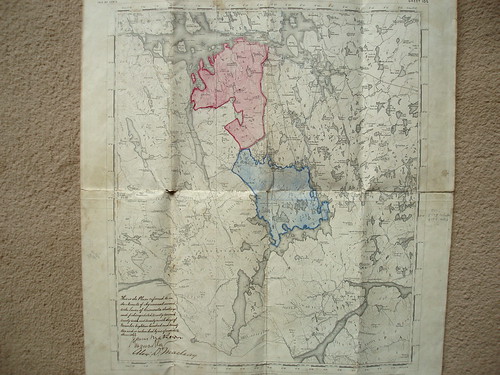
If anyone has any further information about this map, please leave a comment.
The map itself is endorsed with the text:
This is the plan referred to in the Minute of Agreement annexed to the Lease of Grimersta shootings and fishings, dated twenty second, twenty sixth and twenty ninth days of November Eighteen hundred and seventy two and is subscribed by us of even date therewith.
Signed by James Matheson, Alex D. MacLeay and a signature I cannot decipher.

If anyone has any further information about this map, please leave a comment.
Monday 20 August 2007
Community buy-out : Park Estate
The community buy-out in the Park District of Lewis has hit a snag. Although the first community in Lewis to launch a bid, the Park Trust has met with determined opposition from the landlord in the shape of legal wrangles.
The territory of the Park Estate has been leased to Park Crofters, who in turn have subleased it to Park Renewables - for electricity company SSE to use for erecting 57 windturbines on common grazings. Basically, the moorland south and west of the B8060 Balallan to Lemreway road. It should be stressed that Park Crofters is a company controlled by the sitting landowner. The use of this instrument of interposed leases has been contested in the Scottish Land Court by the Scottish Executive and the Park Trust, who have launched the community buy-out bid. The Court has ruled that this is LEGAL under the 2003 Scottish Landreform Act. Legislation introduced since has closed this loophole, and it remains to be seen whether the new clauses can be made to be enforcible retrospectively.
I have previously made clear my strong support to the various community buy-outs across the Highlands and Islands. Although I am not happy with the proposed windfarm, I will say that if it has to go ahead let it at least be to the economic benefit of the Park residents.
The territory of the Park Estate has been leased to Park Crofters, who in turn have subleased it to Park Renewables - for electricity company SSE to use for erecting 57 windturbines on common grazings. Basically, the moorland south and west of the B8060 Balallan to Lemreway road. It should be stressed that Park Crofters is a company controlled by the sitting landowner. The use of this instrument of interposed leases has been contested in the Scottish Land Court by the Scottish Executive and the Park Trust, who have launched the community buy-out bid. The Court has ruled that this is LEGAL under the 2003 Scottish Landreform Act. Legislation introduced since has closed this loophole, and it remains to be seen whether the new clauses can be made to be enforcible retrospectively.
I have previously made clear my strong support to the various community buy-outs across the Highlands and Islands. Although I am not happy with the proposed windfarm, I will say that if it has to go ahead let it at least be to the economic benefit of the Park residents.
Wednesday 15 August 2007
Road Equivalent Tariff
Right, I've decided to stick my neck out on this contentious subject. The Executive in Edinburgh wants to run a pilot project on the Ullapool to Stornoway ferry route, which would see fares slashed by 30%. RET means that ferry fares will be equivalent to the cost of a similar journey by road.
It is suggested that RET could see the cost of taking a car back and forth to Lewis reduced from about £200 to £140, if the 30% is correct. Some figures even quote a fare of £30 for a car. RET would bring hundreds of jobs and millions of pounds of investment. The current cost of Calmac's fares is said to be a stranglehold on the island's economy. A study into the fare structures is to be carried out this year, with the actual pilot running in 2008.
This morning's 6.54am Highlands and Islands news bulletin had an Argyll politician complaining that his area, which is also rich in islands, peninsulas and ferries, was now being deprived of the RET pilot. It would draw tourism away from Argyll to the Western Isles. What utter rubbish. RET is supposed to be for the benefit of the islanders, not primarily for the tourists, although lower fares are bound to attract more people onto the ferries.
I am not 100% convinced of the benefits of RET. I agree that Calmac charges high fares, but it should be born in mind that the company still runs the Ullapool to Stornoway route at a loss. The total subsidy for Calmac is about £30m per annum, which will have to increase if RET is introduced. Subsidies are paid for by the tax payer, including residents of the islands. Calmac is the only company interested in running these life line services; the recent tendering exercise has shown that much. They are running 12 months of the year, including in winter, when hardly anybody is on board. That is something that the man in Argyll has to bear in mind.
It is suggested that RET could see the cost of taking a car back and forth to Lewis reduced from about £200 to £140, if the 30% is correct. Some figures even quote a fare of £30 for a car. RET would bring hundreds of jobs and millions of pounds of investment. The current cost of Calmac's fares is said to be a stranglehold on the island's economy. A study into the fare structures is to be carried out this year, with the actual pilot running in 2008.
This morning's 6.54am Highlands and Islands news bulletin had an Argyll politician complaining that his area, which is also rich in islands, peninsulas and ferries, was now being deprived of the RET pilot. It would draw tourism away from Argyll to the Western Isles. What utter rubbish. RET is supposed to be for the benefit of the islanders, not primarily for the tourists, although lower fares are bound to attract more people onto the ferries.
I am not 100% convinced of the benefits of RET. I agree that Calmac charges high fares, but it should be born in mind that the company still runs the Ullapool to Stornoway route at a loss. The total subsidy for Calmac is about £30m per annum, which will have to increase if RET is introduced. Subsidies are paid for by the tax payer, including residents of the islands. Calmac is the only company interested in running these life line services; the recent tendering exercise has shown that much. They are running 12 months of the year, including in winter, when hardly anybody is on board. That is something that the man in Argyll has to bear in mind.
Wednesday 8 August 2007
Carnival
Just wanted to share a couple of shots from the Lewis Carnival last Saturday. Not as many as I should have taken - but trying to take pictures on South Beach Street was well-nigh impossible. Nonetheless, I have focused on the float which lampooned the airtraffic controller fiasco, reported on on this blog as well.
Thursday 2 August 2007
Sunday sailings
The Hebridean Celtic Festival was expected to have been the stage for a trial run for Sunday sailings on the route between Stornoway and Ullapool, but Calmac said they weren't asked properly. Did someone forget the magic word? PLEASE.
I have posted about this before, and in my opinion we could do with Sunday sailings (even one return crossing) during the summer season. Planes have been flying in and out of the airport for a number of years, the Sunday ferry to Berneray has crossed the Sound of Harris for 16 months now and other islands in Na h-Eileanan Siar are served by CalMac on Sunday. Legally, therefore, opponents to Sunday sailings haven't got a leg to stand on.
I do appreciate, in two senses of that word, the special nature of Sunday on Lewis. It is good to have at least one day when the cars aren't flying round your ears, and you're not compelled to file through the aisles in a supermarket in a forlorn quest for consumer valhalla. I'd like it to stay that way. It is ominous though that the one shop in Stornoway that does open on Sundays is doing a roaring trade.
I hope someone in the Comhairle manages to use the words: "Can we have a ferry sailing on Sunday PLEASE" in correspondence with Calmac one of these days, if only to anticipate the 2008 summer season.
I have posted about this before, and in my opinion we could do with Sunday sailings (even one return crossing) during the summer season. Planes have been flying in and out of the airport for a number of years, the Sunday ferry to Berneray has crossed the Sound of Harris for 16 months now and other islands in Na h-Eileanan Siar are served by CalMac on Sunday. Legally, therefore, opponents to Sunday sailings haven't got a leg to stand on.
I do appreciate, in two senses of that word, the special nature of Sunday on Lewis. It is good to have at least one day when the cars aren't flying round your ears, and you're not compelled to file through the aisles in a supermarket in a forlorn quest for consumer valhalla. I'd like it to stay that way. It is ominous though that the one shop in Stornoway that does open on Sundays is doing a roaring trade.
I hope someone in the Comhairle manages to use the words: "Can we have a ferry sailing on Sunday PLEASE" in correspondence with Calmac one of these days, if only to anticipate the 2008 summer season.
Tuesday 31 July 2007
Face from the War Memorial
This is Private MURDO MACKAY

Murdo last lived in Lewis at 2 Achmore,
He was the son of Norman and Catherine MackayHe served in 1st Battallion, Cameron HighlandersService no: 3/5432He died on 22 December 1914RIPHe is remembered on the memorial at Le Touret, on panels 41 and 42His name is mentioned on the Lewis War Memorial, under Lochs on plaque 1
Murdo Mackay is a casualty of the First World War. His name ranks amongst about 1,200 on the Lewis War Memorial, which stands just north of Stornoway, on a prominent hill - you can't miss it when you enter the town from another part of the island.
When the Great War broke out, some 6,000 islanders entered service with His Majesty's Armed Forces. That is every second man.
One out of every five or six who joined up made the ultimate sacrifice. They were lost in the mud of the trenches, to the U-boats or in the heat of the Arabian desert of what is now Iraq. Another two hundred were lost at a stroke when the Admiralty Yacht "Iolaire" foundered on the Beasts of Holm on 1 January 1919, the third worst maritime disaster in peacetime in the 20th century.
In the links section of this blog, there has been for a few weeks a link to "Faces from the War Memorial". It shows the casualties from the Great War, who originated from Lewis, with a portrait where available. Work is still in progress, and about half of the 400 portraits currently available still need to be incorporated. Additional details are also still being compiled. A claim to completeness cannot be made. A list of maritime casualties is available until the end of this week at the Maritime Exhibition in Stornoway Town Hall. I have been advised that army casualties are not possible to totally verify, as some have fallen unbeknown but unto God.
The "Faces" project was compiled from Loyal Lewis, Roll of Honour 1914-18, the Commonwealth War Graves Commission and with help from Stornoway Historical Society and allied researchers.

Murdo last lived in Lewis at 2 Achmore,
He was the son of Norman and Catherine MackayHe served in 1st Battallion, Cameron HighlandersService no: 3/5432He died on 22 December 1914RIPHe is remembered on the memorial at Le Touret, on panels 41 and 42His name is mentioned on the Lewis War Memorial, under Lochs on plaque 1
Murdo Mackay is a casualty of the First World War. His name ranks amongst about 1,200 on the Lewis War Memorial, which stands just north of Stornoway, on a prominent hill - you can't miss it when you enter the town from another part of the island.
When the Great War broke out, some 6,000 islanders entered service with His Majesty's Armed Forces. That is every second man.
One out of every five or six who joined up made the ultimate sacrifice. They were lost in the mud of the trenches, to the U-boats or in the heat of the Arabian desert of what is now Iraq. Another two hundred were lost at a stroke when the Admiralty Yacht "Iolaire" foundered on the Beasts of Holm on 1 January 1919, the third worst maritime disaster in peacetime in the 20th century.
In the links section of this blog, there has been for a few weeks a link to "Faces from the War Memorial". It shows the casualties from the Great War, who originated from Lewis, with a portrait where available. Work is still in progress, and about half of the 400 portraits currently available still need to be incorporated. Additional details are also still being compiled. A claim to completeness cannot be made. A list of maritime casualties is available until the end of this week at the Maritime Exhibition in Stornoway Town Hall. I have been advised that army casualties are not possible to totally verify, as some have fallen unbeknown but unto God.
The "Faces" project was compiled from Loyal Lewis, Roll of Honour 1914-18, the Commonwealth War Graves Commission and with help from Stornoway Historical Society and allied researchers.
Monday 30 July 2007
Find an air-traffic controller
With thanks to Annie B for the reminder.
In recent times, Stornoway Airport has suffered a shortage of air-traffic controllers. If one went off sick, it would leave the airport unmanned and therefore shut. One afternoon, last winter, it closed at 3.20pm and left a number of high-profile individuals high and dry. Or should that be low and dry, as they could not get airborne. Oh the inconvenience. Distracted our MP from cash for honours for a day. Perhaps that contributed to the scuppering of that inquiry. Wheesht.
Anyway, the other day, the same situation threatened to develop, and there was this beautiful new helicopter sitting on the tarmac, doing nothing. And wasn't the other air-traffic controller out fishing on Loch Langavat? What a nice exercise, send the chopper off to Langavat to find said ATC and airlift him to work.
The only problem is that Langavat is the largest loch on Lewis, 8 miles long, and it's quite easy to hide under the heather along its shores. So, Mike Uniform returned without ATC - I cannot remember how many if any flights were cancelled, I think it was three at most. And shock horror, if an emergency had arisen whilst Mike Uniform was fishing for trout on Langavat, it would have led to unacceptable delays in response times - or would it? Langavat is 25 miles southwest of Stornoway, which is about 10 minutes flying time.
Yes it's daft to send a helicopter out to look for a replacement member of staff. It just showed up, once again, that staffing crisis at the airport, and the ridiculous pressure being brought to bear to avoid closure of the airport as a result. C'mon folks, where are those brandnew airtraffic controllers?
In recent times, Stornoway Airport has suffered a shortage of air-traffic controllers. If one went off sick, it would leave the airport unmanned and therefore shut. One afternoon, last winter, it closed at 3.20pm and left a number of high-profile individuals high and dry. Or should that be low and dry, as they could not get airborne. Oh the inconvenience. Distracted our MP from cash for honours for a day. Perhaps that contributed to the scuppering of that inquiry. Wheesht.
Anyway, the other day, the same situation threatened to develop, and there was this beautiful new helicopter sitting on the tarmac, doing nothing. And wasn't the other air-traffic controller out fishing on Loch Langavat? What a nice exercise, send the chopper off to Langavat to find said ATC and airlift him to work.
The only problem is that Langavat is the largest loch on Lewis, 8 miles long, and it's quite easy to hide under the heather along its shores. So, Mike Uniform returned without ATC - I cannot remember how many if any flights were cancelled, I think it was three at most. And shock horror, if an emergency had arisen whilst Mike Uniform was fishing for trout on Langavat, it would have led to unacceptable delays in response times - or would it? Langavat is 25 miles southwest of Stornoway, which is about 10 minutes flying time.
Yes it's daft to send a helicopter out to look for a replacement member of staff. It just showed up, once again, that staffing crisis at the airport, and the ridiculous pressure being brought to bear to avoid closure of the airport as a result. C'mon folks, where are those brandnew airtraffic controllers?
Wednesday 25 July 2007
Hebridean Celtic Festival - service complaints
My eyebrows hit the ceiling this morning, when the newsfeed for the Highlands and Islands coughed up this story that people attending the HCF two weeks ago complained about the level of service.
The Hebrides are justifiably famous for hospitality, and this sort of feedback comes as an unpleasant surprise. Basically, people grumble at the length of time they had to wait to be served, either in shops or in restaurants and the like.
I have to say that this is the first time in the 12 years of the HCF that such complaints have surfaced, to my knowledge at any rate. The Festival is enjoying a continuing surge of interest, with close to 15,000 people coming to Lewis to attend. It should born in mind though that the total resident population in this island is about 20,000, so such a large influx puts a strain on human resources.
Lessons should be learned for the 2008 festival, so that adequate staff are hired in good time by various establishments. There is talk of a staffbank being set up. The only problem is that the summer season is short, and for the rest of the year (between October and Easter), alternative employment would have to be found for these folk; unless they are drafted in from elsewhere in Scotland or beyond.
I sincerely hope that those who experienced a level of service below their expectation during the Festival are not put off revisiting, and are willing to bear in mind that this was an extremely busy time for the island.
The Hebrides are justifiably famous for hospitality, and this sort of feedback comes as an unpleasant surprise. Basically, people grumble at the length of time they had to wait to be served, either in shops or in restaurants and the like.
I have to say that this is the first time in the 12 years of the HCF that such complaints have surfaced, to my knowledge at any rate. The Festival is enjoying a continuing surge of interest, with close to 15,000 people coming to Lewis to attend. It should born in mind though that the total resident population in this island is about 20,000, so such a large influx puts a strain on human resources.
Lessons should be learned for the 2008 festival, so that adequate staff are hired in good time by various establishments. There is talk of a staffbank being set up. The only problem is that the summer season is short, and for the rest of the year (between October and Easter), alternative employment would have to be found for these folk; unless they are drafted in from elsewhere in Scotland or beyond.
I sincerely hope that those who experienced a level of service below their expectation during the Festival are not put off revisiting, and are willing to bear in mind that this was an extremely busy time for the island.
Tuesday 24 July 2007
Exiles

This statue, entitled Exiles, was unveiled by First Minister Alex Salmond yesterday, at Helmsdale on the east Sutherland coast. It shows a family, leaving their homes for a new life overseas. Helmsdale lies at the mouth of the Strath of Kildonan, one of many valleys in Sutherland cleared of their residents in the 19th century. The full background story can be read here.
Whilst I applaud the efforts of Mr Macleod (who initiated the project) to keep the memory of the Clearances alive, I somehow find the positive gloss being cast on this appalling episode in Scotland's history very, very difficult to stomach. Particularly, bearing in mind Mr Salmond's political hue, I would have expected to hear rather stronger language than "deplorable".
Thousands of people were forced by means fair and foul to leave their homes - the practice of burning the thatch over people's heads is well documented. The Isle of Skye, 35 miles south of here, has been the scene of some atrocious evictions. Late last year, the assertion was being made that the Isle of Lewis had suffered relatively lightly under the Clearances. Well, I couldn't disagree more.
Early in 2006, I published the below map on this blog, showing the district of Eishken and 27 villages which used to be there until 1820.

They were all cleared, mostly to other places within Lewis. But still a forcible eviction.
I agree that the people who were cleared out of northern Scotland did make a contribution in the areas where they settled. But I think it is a stinging indictment that their contribution was not appreciated in their homecountry, and I am waiting for the First Minister to say something about that too.
Monday 23 July 2007
South Lochs
Explored the district of South Lochs yesterday afternoon. I know it quite well, having stayed in the area for 3 months in the winter of 2004/5. Managed to see all the villages there, and re-acquaint myself with its scenic beauty.
South Lochs is also the district which will be directly affected by a windfarm development by Scottish and Southern Energy (SSE), who intend to erect 500 ft turbines on the moors there. In my opinion that would destroy the visual and tourist amenity of the area. The hills there are not very high, I think the highest ones reach below 600 ft. Below image shows the central area where turbines are planned to be.
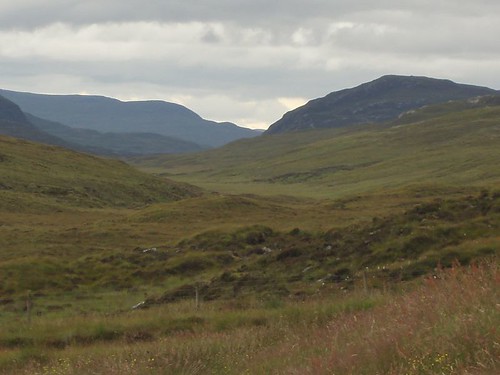
Glen Ouirn, west of Gravir

Garyvard, seen from Caversta
Currently, South Lochs' development is being stymied by non-cooperation from the sitting landlord. He is also frustrating efforts by the local community to mount a buy-out bid. The Scottish Land Courts are sitting in judgment on the instrument of interposed leases, which allow the landowner to scatter his land amongst a number of companies - which he himself has set up.
I am a strong supporter of community buy-out, and have been for more than a decade. I am also a strong opponent of the major windfarm developments in Lewis. South Lochs is not just going to be affected by the 57 turbines within the boundaries of the Pairc Estate, but will also have the turbines in the neighbouring Eishken Estate frowning over it.
South Lochs could do worse than exploit its tourism potential a lot further, rather than destroying it with vast turbine towers
South Lochs is also the district which will be directly affected by a windfarm development by Scottish and Southern Energy (SSE), who intend to erect 500 ft turbines on the moors there. In my opinion that would destroy the visual and tourist amenity of the area. The hills there are not very high, I think the highest ones reach below 600 ft. Below image shows the central area where turbines are planned to be.

Glen Ouirn, west of Gravir

Garyvard, seen from Caversta
Currently, South Lochs' development is being stymied by non-cooperation from the sitting landlord. He is also frustrating efforts by the local community to mount a buy-out bid. The Scottish Land Courts are sitting in judgment on the instrument of interposed leases, which allow the landowner to scatter his land amongst a number of companies - which he himself has set up.
I am a strong supporter of community buy-out, and have been for more than a decade. I am also a strong opponent of the major windfarm developments in Lewis. South Lochs is not just going to be affected by the 57 turbines within the boundaries of the Pairc Estate, but will also have the turbines in the neighbouring Eishken Estate frowning over it.
South Lochs could do worse than exploit its tourism potential a lot further, rather than destroying it with vast turbine towers
Tuesday 17 July 2007
New helicopter
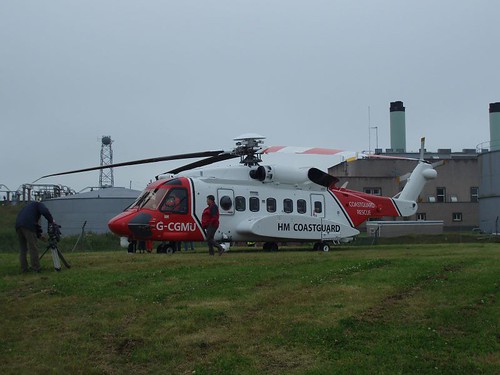
This morning, coastguard helicopter Mike Uniform touched down outside the Coastguard Station in Stornoway. It is a new aircraft, costing a trifling £16 million, which will come into full operation on 1 September. The helicopter will relocate to Stornoway Airport, 3 miles away, shortly. A number of people went over to have a look round the new machine. The crew is being trained to use the S-92 Sikorsky helicopter in its normal deployments for Search and Rescue. The old machines, designed 46 years ago, will be phased out this autumn.
Tomorrow, the aircraft will be on show at Sumburgh Airport in Shetland. Helicopters are based at Stornoway, Sumburgh, Portland (Dorset) and Lee-on-Solent (Hampshire). There was initially some misgivings about the Sikorsky, as it has no track record in SAR.
Monday 16 July 2007
Midnight gloaming
< ]]>
]]>
 ]]>
]]>
Thursday 12 July 2007
Entry of the fleet
It's Festival Week in Stornoway, and apart from much music, it is also the time for Sail Hebrides. In spite of some dreich conditions, the entry of the little flotilla, shepherded by coastguard tug Anglian Prince, went smoothly. A few pics:

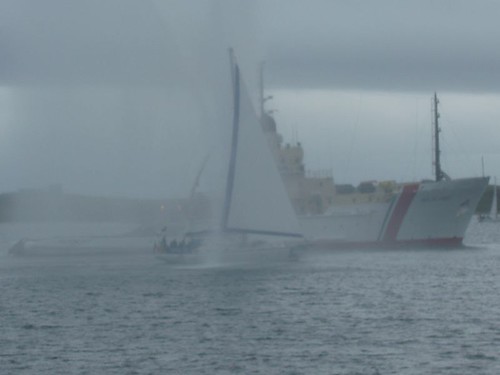
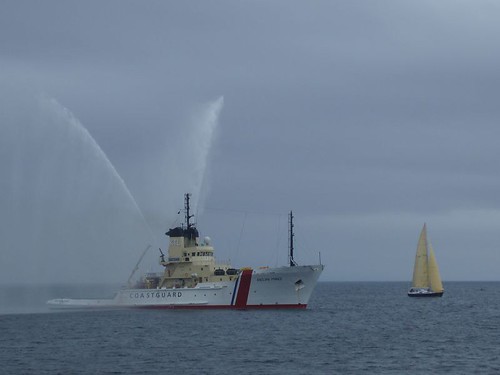
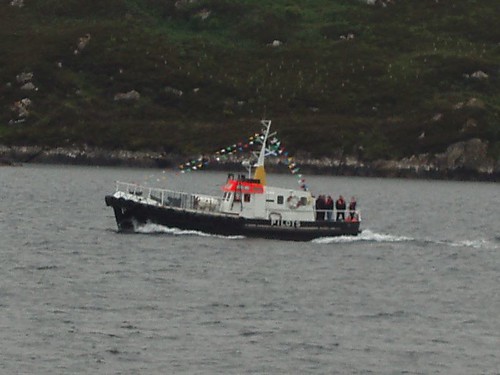




Harris Tweed U-turn
The multi-million pound order for Harris Tweed, initially declined by Mackenzie's Mills in Stornoway is now apparently back on again. Mill owner, Yorkshireman Brian Haggas, has declared that a reduction in patterns will not take place until the end of the year. The order will provide work until next March. It was also announced that the Shawbost mill, closed by Mr Haggas' predecessor Mr Murray, will be reopened to operate in competition with the Stornoway enterprise.
I think it's a very good idea to have a bit of local competition, as this is likely to prevent the wholesale ditching of the thousands of patterns. It would also appear that the German company had a contract, which they felt to be enforceable. It is for 75,000 yards of tweed, containing 20 patterns.
I think it's a very good idea to have a bit of local competition, as this is likely to prevent the wholesale ditching of the thousands of patterns. It would also appear that the German company had a contract, which they felt to be enforceable. It is for 75,000 yards of tweed, containing 20 patterns.
Monday 9 July 2007
Harris Tweed problems
Weavers and millworkers in the Harris Tweed industry in Lewis have reacted with horror to the announcement that a large order has been refused by industry owner Mr Haggas, as I quoted in previous post. .
A cooperative may now be set up independently to safeguard the continuity of the industry. One mill remains outside the realm of formerly Mackenzie's mills, which is the wee place over at Carloway. Their current market segment has been put at around 5%, and they're only working 3 days a week. My info may be out of date.
I hope this venture does win through, otherwise the Harris Tweed industry is down the tubes.
A cooperative may now be set up independently to safeguard the continuity of the industry. One mill remains outside the realm of formerly Mackenzie's mills, which is the wee place over at Carloway. Their current market segment has been put at around 5%, and they're only working 3 days a week. My info may be out of date.
I hope this venture does win through, otherwise the Harris Tweed industry is down the tubes.
Saturday 7 July 2007
Harris Tweed order refused
The new owner of the largest producer of Harris Tweed in the Western Isles, Brian Haggas, has declined one of the largest orders for Harris Tweed in 20 years. The order originated from Germany. Initially, weavers and producers had been delighted at the prospect of this order. Mr Haggas declined to comment, saying it was an internal matter.
The new owner has previously announced he would severely restrict the number of patterns (from thousands to 5), and that he would also focus on men's jackets.
It would appear that the Harris Tweed industry is continuing its decades long decline into oblivion at a steady pace.
The new owner has previously announced he would severely restrict the number of patterns (from thousands to 5), and that he would also focus on men's jackets.
It would appear that the Harris Tweed industry is continuing its decades long decline into oblivion at a steady pace.
Tuesday 3 July 2007
Gloup Disaster
Blogging out of area again, I was listening to a program on BBC Scotland about the Gloup Disaster. This occurred on 20 July 1881, and claimed the lives of 36 fishermen from the Isle of Yell in Shetland. As the 126th anniversary is coming up, I would like to dedicate this entry to their memory. Although I am obviously blogging from Lewis, the theme is common to many island communities.
Following a period of bad weather, a clearance prompted the fishermen of Gloup to take to the fishing grounds, 40 miles out to the west. Unbeknown to them, a summer storm raced towards Shetland and fell ont hem with hurricane force winds. Many boats were found overturned with no sign of life.
Fifty-eight fishermen drowned, 36 of whom came from Gloup. They left 34 widows and 85 orphans.
Following a period of bad weather, a clearance prompted the fishermen of Gloup to take to the fishing grounds, 40 miles out to the west. Unbeknown to them, a summer storm raced towards Shetland and fell ont hem with hurricane force winds. Many boats were found overturned with no sign of life.
Fifty-eight fishermen drowned, 36 of whom came from Gloup. They left 34 widows and 85 orphans.
Lunar Standstill
Went to view the Lunar Standstill at Callanish late on Friday evening, only to be met by a cloudy southeastern skyline. It took an hour, after sunset at 10.30, for the moon to appear, by which time it was just above the head of the Cailleach nam Mointeach (the hill of Roineabhal near Balallan). Light was obviously very low at that point, but here is a selection of pictures. There was a pretty large number of people out to watch, even if it was a chilly evening. I'd put the number at around 50.
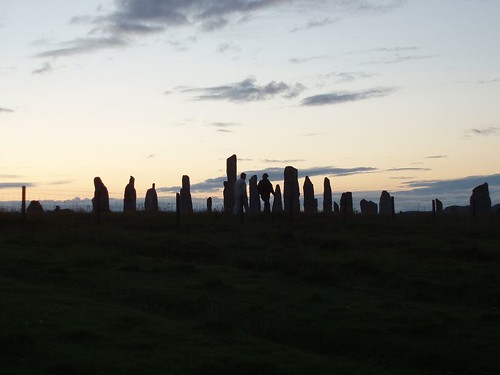
The Callanish Stones at dusk
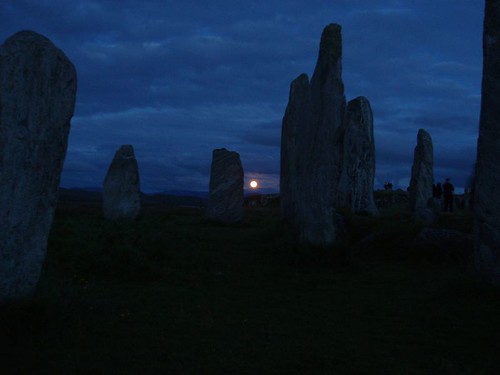
Moon shining through the Stones
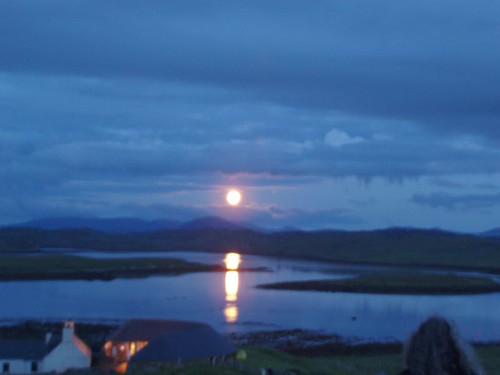
Moon just past the Sleeping Beauty
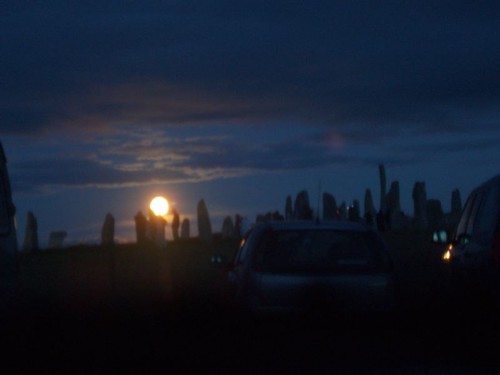
The Stones at midnight

The Callanish Stones at dusk

Moon shining through the Stones

Moon just past the Sleeping Beauty

The Stones at midnight
Wednesday 27 June 2007
Illegal dam and former health board chairman
Cliasmol School in Harris, which stands in splendid isolation along the Huisinis road, has been without water because its watersupply has been usurped by the home of the previous chairman of the Western Isles Health Board. He built a dam, without permission, to divert water from a stream to his home rather than to the school. Bowsers are now supplying the school with water for taps and toilets, and the Council has written to the ex-chairman to remove the dam.
No further comment necessary, I think.
No further comment necessary, I think.
Monday 25 June 2007
Lunar Standstill and Callanish
On Thursday night of this week, a lunar standstill will occur as seen from the Callanish Stones. When viewed from the northern end of the Stones, the moon will appear to rise from behind the Sleeping Beauty range of hills (located in Eishken, south of Airidh a'Bhruaich), pass behind one other hill and set in the southwest. It is a rare phenomenon, only properly seen every 18.6 years. Victor Reijs, who used to operate a webcam at Callanish (blown over in last winter's gales) has an extensive webpage.
A call was made by local archeologist Ian McHardy for people to gather at Callanish at sunset on Thursday evening (10.30pm) to observe the lunar standstill. If the Eishken windfarm is built, the next standstill (in 2026) will be spoiled by the turbines. To quote Mr McHardy: you'd be looking at a windfarm, not a Sleeping Beauty. And for the first time in 5,000 years, the purpose of the Callanish Stones will be spoiled. So, pass word round, and try to be there this Thursday.
A call was made by local archeologist Ian McHardy for people to gather at Callanish at sunset on Thursday evening (10.30pm) to observe the lunar standstill. If the Eishken windfarm is built, the next standstill (in 2026) will be spoiled by the turbines. To quote Mr McHardy: you'd be looking at a windfarm, not a Sleeping Beauty. And for the first time in 5,000 years, the purpose of the Callanish Stones will be spoiled. So, pass word round, and try to be there this Thursday.
Friday 22 June 2007
Stationary turbines
Yesterday, the Stornoway Gazette cast some light on the enigmatic windturbines down at Grimshader, although they needed the Battery Point powerstation to generate the power for that light. You see, the turbines on the Arnish Moor are notorious for not turning. Don't think that we haven't got the wind to make them go. We do. But, it was found that the local electricity grid was unable to cope with the variable output that you get from a wind turbine. It needs upgrading, and that's something planned somewhere in the next 5 to 10 years.
The point behind the stationary turbines is that the wind does not blow at a constant speed. With the changes in the weather, which happen fast and furious up here, windspeeds vary wildly. At higher windspeeds, the turbines obviously generate more power - but when the wind drops, so does your output. And your average electrical appliance does not work terribly well when your power supply fluctuates. It wreaks havoc with the lifespan of a lightbulb, and can cause serious damage. So, in recent times, the eastern part of Stornoway has been going to sleep to the dulcet roar of the Battery Point powerstation, going at full blast to supply the island with electricity. Of course, we do have a mainland link-up through Skye. But it would appear that this is not too reliable either.
Point I am making is that at best, those turbines have been installed 5 to 10 years early, because they will only be able to operate when the local grid can cope with their vagaries. The other thing is a general point, which is being made on account of these problems, that once the three windfarms come on stream (if they ever do), the same problem will apply on a much larger scale. And, you'll always need a back-up from another source to supply power when there is too little or too much wind.
As I am writing about wind energy, I might as well chip in on the Pairc Windfarm. The planning application is avaiable for perusal in Stornoway Library, and objections can be raised until (I think) mid July. It is going to be an absolute eyesore. The hills of South Lochs are low, and these 500 ft monstrosities will be dominating the skyline for dozens of miles around.
The point behind the stationary turbines is that the wind does not blow at a constant speed. With the changes in the weather, which happen fast and furious up here, windspeeds vary wildly. At higher windspeeds, the turbines obviously generate more power - but when the wind drops, so does your output. And your average electrical appliance does not work terribly well when your power supply fluctuates. It wreaks havoc with the lifespan of a lightbulb, and can cause serious damage. So, in recent times, the eastern part of Stornoway has been going to sleep to the dulcet roar of the Battery Point powerstation, going at full blast to supply the island with electricity. Of course, we do have a mainland link-up through Skye. But it would appear that this is not too reliable either.
Point I am making is that at best, those turbines have been installed 5 to 10 years early, because they will only be able to operate when the local grid can cope with their vagaries. The other thing is a general point, which is being made on account of these problems, that once the three windfarms come on stream (if they ever do), the same problem will apply on a much larger scale. And, you'll always need a back-up from another source to supply power when there is too little or too much wind.
As I am writing about wind energy, I might as well chip in on the Pairc Windfarm. The planning application is avaiable for perusal in Stornoway Library, and objections can be raised until (I think) mid July. It is going to be an absolute eyesore. The hills of South Lochs are low, and these 500 ft monstrosities will be dominating the skyline for dozens of miles around.
Canoe tragedy
A member of the public spotted a body floating in the sea off Bragar at 6.50 am today. He alerted the emergency services, who recovered it to dry land. Identification confirmed it was that of Daniel McTaggart, the 12-year old boy from Arnol who has been missing since earlier this month.
He went out for a canoeing trip with his father, when something went wrong. The father, Joe, was found shortly after the incident floating in the sea, and was taken to hospital in Stornoway where he died. Search parties were mounted for Daniel in the aftermath of the tragedy, but yielded no results - until today.
However tragic this case, at least there is now closure for the family. I wish them strength at this difficult time.
He went out for a canoeing trip with his father, when something went wrong. The father, Joe, was found shortly after the incident floating in the sea, and was taken to hospital in Stornoway where he died. Search parties were mounted for Daniel in the aftermath of the tragedy, but yielded no results - until today.
However tragic this case, at least there is now closure for the family. I wish them strength at this difficult time.
Wednesday 20 June 2007
Solstice sunsets
A few images of sunsets of the last few days, which have been quite magnificent. Also to show how light it still is late in the evening. Yes, I know, those in the Northern Isles have even lighter nights.
19 June 2007
19 June 2007
Tuesday 19 June 2007
St Kilda week
 A series of events takes place in Lewis and Harris this week surrounding St Kilda and its culture. Street theatre will feature on the streets of Stornoway on Thursday, Friday and Saturday at 12 and 12.30pm. The mainstay of the event is St Kilda, a European Opera. This will be performed on Friday evening at 20.10 GMT, which is 21.10 BST, and can be viewed LIVE on-line on www.bbc.co.uk/stkildaopera. This link will not be operational until the night of the performance.
A series of events takes place in Lewis and Harris this week surrounding St Kilda and its culture. Street theatre will feature on the streets of Stornoway on Thursday, Friday and Saturday at 12 and 12.30pm. The mainstay of the event is St Kilda, a European Opera. This will be performed on Friday evening at 20.10 GMT, which is 21.10 BST, and can be viewed LIVE on-line on www.bbc.co.uk/stkildaopera. This link will not be operational until the night of the performance.The week's events are highlighted on a dedicated website, which has all the latest information.
Monday 18 June 2007
Solstice - irrelevant?
This Thursday will see the summer solstice 2007, and I'm quietly relieved that the forecast isn't too good. As per usual, the Callanish Stones will be a focal point for sun worshippers (not for tanning purposes, mind), druids and the like. All of whom I wish a thoroughly enjoyable and spiritually enhancing time, but I really wonder what they are doing at Callanish.
This monument, one of the oldest in the British Isles, appears to have been laid out to capture various LUNAR events. Related to the moon, just to press the point home. A few weeks ago, the moon was very low in the sky, I think only 4° above the horizon at its highest point. This is the juncture where it appears to set behind a hill in Lochs, rise on its other side and finally set behind the Clisham.
Anyway, I don't want to deprive people of a nice time. I'll be out late one of these evenings to capture the 'late light'.
This monument, one of the oldest in the British Isles, appears to have been laid out to capture various LUNAR events. Related to the moon, just to press the point home. A few weeks ago, the moon was very low in the sky, I think only 4° above the horizon at its highest point. This is the juncture where it appears to set behind a hill in Lochs, rise on its other side and finally set behind the Clisham.
Anyway, I don't want to deprive people of a nice time. I'll be out late one of these evenings to capture the 'late light'.
Tuesday 12 June 2007
Eigg's 10th anniversary
 I apologise for blogging out of area again, but I can't just let the 10th anniversary of the Isle of Eigg buy-out go past without a mention on here. Also, bearing in mind that there are, as yet, no island bloggers from the island.
I apologise for blogging out of area again, but I can't just let the 10th anniversary of the Isle of Eigg buy-out go past without a mention on here. Also, bearing in mind that there are, as yet, no island bloggers from the island.Eigg was privately owned until 1997, and successive owners did not do much for the island's economic prosperity. In fact, wanton neglect was the order of the day after 1966, when the Runciman family sold up. A series of maverick owners moved into the Lodge (the proprietor's residence), and the last two were the last straw. Keith Schellenberg took over in 1975, and appeared to come in with new ideas.
Unfortunately, a string of incidents soured things irrevocably and Mr Schellenberg sold to a crackpot German artist, known as Marlin Eckhardt Maruma. He shot paint at a canvas, set it on fire, and called it art. He bought Eigg as a security against a £3m loan - which was based on thin air. When this was found out, the island was put on the market again. The islanders now had their act together, and managed to gather up the £2m asking price.
I have visited Eigg on and off since 1989, and on my last visit in 2004, things had improved beyond recognition. By the end of this year, Eiggachs will have their own mains electricity, generated from hydro, solar and windpower. Previously, they had to rely on capricious diesel generators.
I once again salute the people of Eigg for their enterprise and wish them every piece of good luck in the years ahead.
Monday 11 June 2007
Dolphins at Lower Sandwick
I was told this morning that dolphins were stuck in the bay by Lower Sandwick, so I duly went down the road to have a look. A Coastguard team was in attendance, as was the local vet. The dolphins, both measuring about 8 feet in length, were separately hauled up to the shore on a tarpaulin. The vet assessed their state of health, which was found to be quite poor. Neither animal was able to maintain their natural posture in the water, and had other injuries. How they sustained their injuries will never be known. The decision was taken to euthanise both dolphins, a duty carried out by the vet.
I was very sad at the demise of these two creatures, but it was unavoidable. Their carcases are likely to be taken away from Lower Sandwick for disposal at the Bennadrove dump.
I would like to thank the representatives from the Coastguard for taking the time to fill me in on the situation at the scene.
UPDATE: There were 5 dolphins trapped in the bay, but the other three managed to free themselves on the rising tide at 1 pm.
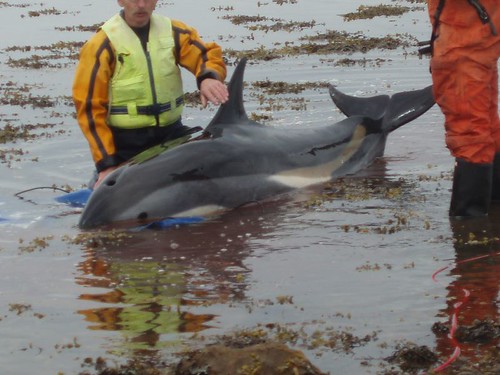
I was very sad at the demise of these two creatures, but it was unavoidable. Their carcases are likely to be taken away from Lower Sandwick for disposal at the Bennadrove dump.
I would like to thank the representatives from the Coastguard for taking the time to fill me in on the situation at the scene.
UPDATE: There were 5 dolphins trapped in the bay, but the other three managed to free themselves on the rising tide at 1 pm.

Friday 8 June 2007
Hebridean Celtic Festival
It would appear that the Hebridean Celtic Festival, billed for 11-14 July this year, looks set to attract record numbers of visitors. The previous years were equally record breaking, and the HebCelt office on Cromwell Street says that 2007 looks to be no exception. This in spite of the close proximity (in terms of time) of the festival to Elton John's gig over in Inverness.
The main challenge is to accommodate everybody that wants to come. The festival website has more information on this issue, including contact points for people who have a room to spare.
In addition, I strongly suggest that anyone as yet without accommodation consider staying outside Stornoway, and organise a vehicle to get to the gigs and back again. Public transport ceases at 8pm on weekdays, and 11pm on Friday and Saturday. The concerts commonly finish after midnight. For those unfamiliar with Lewis it may be benificial to know that distances to the town are never more than about 25 miles, with the district of Uig the sole exception at 35 miles distance.
The main challenge is to accommodate everybody that wants to come. The festival website has more information on this issue, including contact points for people who have a room to spare.
In addition, I strongly suggest that anyone as yet without accommodation consider staying outside Stornoway, and organise a vehicle to get to the gigs and back again. Public transport ceases at 8pm on weekdays, and 11pm on Friday and Saturday. The concerts commonly finish after midnight. For those unfamiliar with Lewis it may be benificial to know that distances to the town are never more than about 25 miles, with the district of Uig the sole exception at 35 miles distance.
Thursday 7 June 2007
Local Mod
The Lewis Local Mod is on this week, between 5th and 8th June. I have attended a handful of the competitions; yesterday and today, I sat in on the Folk Groups from Primary and Secondary Schools from across the island. Recorded some of the performances, which can be listened to by accessing this webpage. I was unable to keep tabs on performances by the secondary schools, but the primary schools performed as per order.
Tuesday 5 June 2007
Canoe tragedy
There has been extensive media coverage in the north of Scotland about the canoeing tragedy off Arnol and Bragar, on the West Side of Lewis. Image above shows the coastline near Bragar.
Sixty-year old Joe McTaggart and his 12-year old son Daniel set out in a canoe from their home village of Arnol yesterday (Monday) afternoon. It would appear that they got into difficulties fairly soon after setting forth. A woman out on the shore near the neighbouring village of Bragar noticed a canoe with two people on the water. When she found the canoe washed up on the beach at Bragar 15 minutes later, she raised the alarm with the Coastguard.
Yesterday evening, five coastguard teams from across Lewis combed 5 miles of coastline between Shawbost and Barvas, assisted by the coastguard helicopter and the Stornoway lifeboat. Joe McTaggart was found in the water, and was transported to Western Isles Hospital in Stornoway, where he was pronounced dead. His son was still missing, but the search continued until light started to fail at 10.30pm.
This morning at 3.30 am, at first light, the search was resumed, but after several sweeps of the coastline the lifeboat and helicopter were stood down. A shoreline search will continue through today and beyond. A large number of local people have assisted police and coastguard in looking for Daniel.
Mrs McTaggart, speaking on regional television this evening, said that although a slim chance remained for her son to be found alive, she was resigned to her loss, and was convinced that she would meet up with her loved ones in a better place.
I would like to express my sympathies to the family at this sad time.
Sixty-year old Joe McTaggart and his 12-year old son Daniel set out in a canoe from their home village of Arnol yesterday (Monday) afternoon. It would appear that they got into difficulties fairly soon after setting forth. A woman out on the shore near the neighbouring village of Bragar noticed a canoe with two people on the water. When she found the canoe washed up on the beach at Bragar 15 minutes later, she raised the alarm with the Coastguard.
Yesterday evening, five coastguard teams from across Lewis combed 5 miles of coastline between Shawbost and Barvas, assisted by the coastguard helicopter and the Stornoway lifeboat. Joe McTaggart was found in the water, and was transported to Western Isles Hospital in Stornoway, where he was pronounced dead. His son was still missing, but the search continued until light started to fail at 10.30pm.
This morning at 3.30 am, at first light, the search was resumed, but after several sweeps of the coastline the lifeboat and helicopter were stood down. A shoreline search will continue through today and beyond. A large number of local people have assisted police and coastguard in looking for Daniel.
Mrs McTaggart, speaking on regional television this evening, said that although a slim chance remained for her son to be found alive, she was resigned to her loss, and was convinced that she would meet up with her loved ones in a better place.
I would like to express my sympathies to the family at this sad time.
Friday 1 June 2007
Midnight light
We're in the season of light nights again, and when I popped outside half an hour ago, I was treated to the below spectacle
Looking north

Looking south
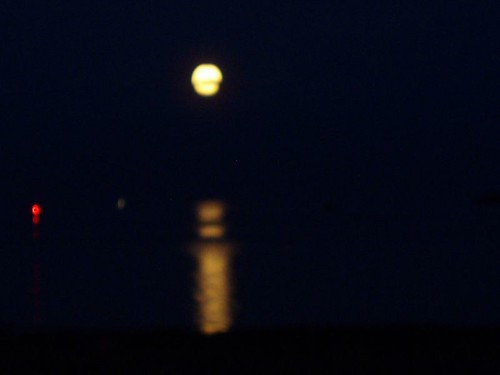
Looking north

Looking south

Tuesday 29 May 2007
West Side excursion
Over the weekend, I had the opportunity for a drive round the West Side of Lewis. The result was a good collection of pictures, some of which I would like to share.
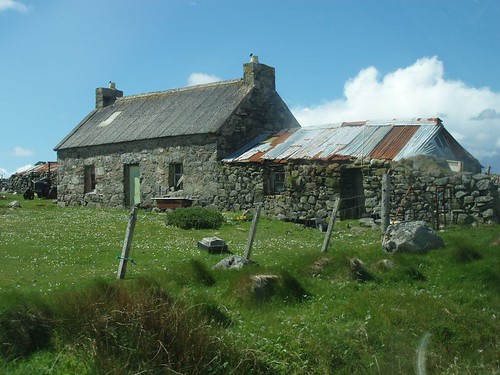
Old crofthouse at Brue

The Arnol Blackhouse

North Shawbost
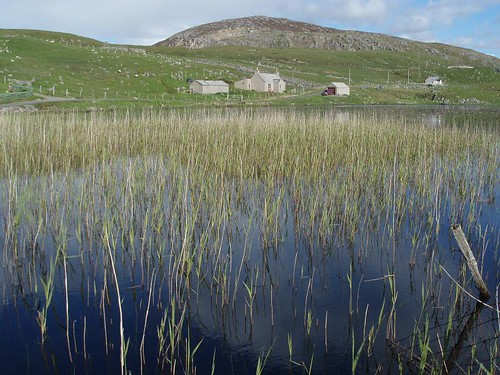
Dalbeg and its loch
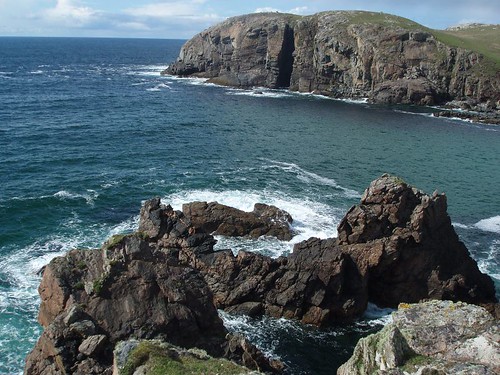
Beyond Dalbeg's stack
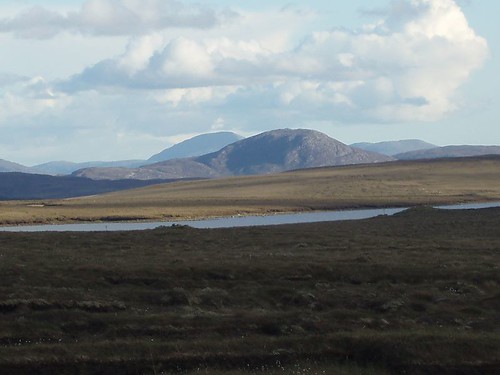
Roineabhal near Balallan as seen from the Pentland Road at 7.30pm

Sunset near Grimshader
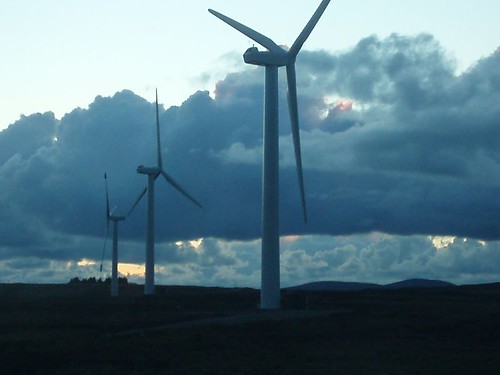
Windturbines on the Arnish Moor
The last picture does not convey the sound made by the farthest turbine, which was rotating at the time. I took the sunset picture near Loch Orasay, a mile to the south, and could still hear the hum of the generator. Imagine the sound when all three turbines are working; imagine the sound made by 180 turbines... Who said windturbines were quiet? The visual impact is of course the greatest.

Old crofthouse at Brue

The Arnol Blackhouse

North Shawbost

Dalbeg and its loch

Beyond Dalbeg's stack

Roineabhal near Balallan as seen from the Pentland Road at 7.30pm

Sunset near Grimshader

Windturbines on the Arnish Moor
The last picture does not convey the sound made by the farthest turbine, which was rotating at the time. I took the sunset picture near Loch Orasay, a mile to the south, and could still hear the hum of the generator. Imagine the sound when all three turbines are working; imagine the sound made by 180 turbines... Who said windturbines were quiet? The visual impact is of course the greatest.
Subscribe to:
Posts (Atom)